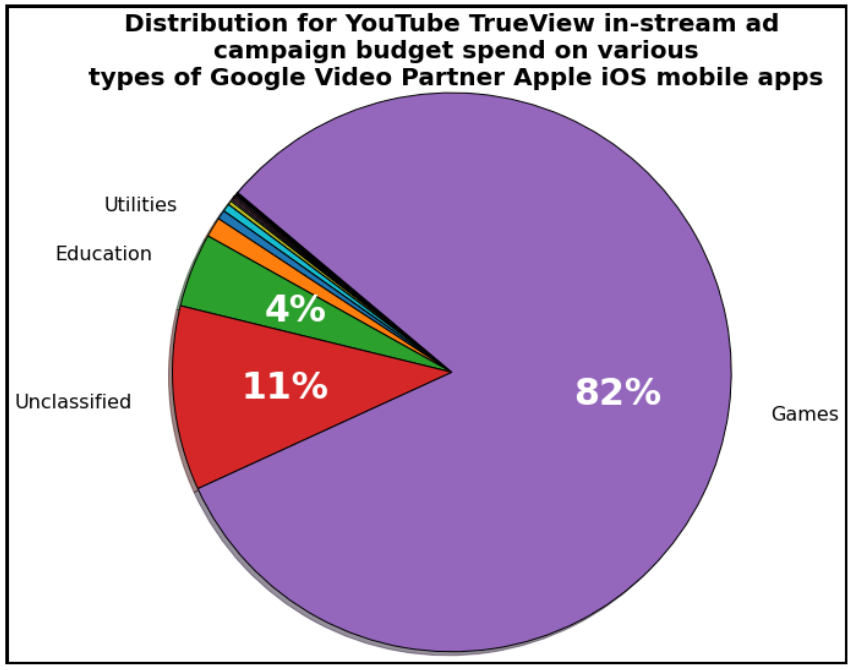⚠️ Note: A PDF copy of this report can be downloaded from this URL link. ⚠️
This report finds that advertisers including Fortune 500 brands, the US federal government, and many small businesses may have been misled for years about Google’s proprietary TrueView skippable in-stream video ads. This misalignment may have cost media buyers up to billions of digital ad dollars, which were ultimately spent on small, muted, out-stream, auto-playing or interstitial video ad units running on independent websites and mobile apps.
TrueView is Google's “proprietary cost-per-view, choice-based ad format that serves on YouTube, millions of apps, and across the web.” With TrueView, advertisers only pay “for actual views of their ads, rather than impressions.” TrueView asks users if they want to skip the video ad after 5 seconds with a visual prompt. Google’s policies state that TrueView ads must be skippable, audible, and playing of the video (and ad) cannot be solely initiated by passive user scrolling.
However, this research report finds that for years, significant quantities of TrueView skippable in-stream ads, purchased by many different brands and media agencies, appear to have been served on hundreds of thousands of websites and apps in which the consumer experience did not meet Google’s stated quality standards. For example, many TrueView in-stream ads were served muted and auto-playing as out-stream video or as obscured video players on independent sites. Often, there was little to no organic video media content between ads, the video units simply played ads only.
For a major infrastructure brand, only ~16% of their TrueView skippable in-stream video ad budget was spent on YouTube.com or YouTube’s apps. The majority of their budget was spent on tens of thousands of different websites or mobile apps which make up the Google Video Partner (GVP) network. The majority of those GVP mobile apps and websites served the TrueView skippable in-stream video ads in outstream, muted, auto-playing, interstitial, and/or non-visible ad slots - which are inconsistent with the TrueView or skippable in-stream ad format.
Adalytics shared examples of these TrueView skippable in-stream placements with advertisers and media buyers. Several dozen marketers stated that they would not have purchased this TrueView skippable in-stream inventory running on 3rd party environments, if this fact was clearly explained to them in advance. Marketers also shared that they did not expect or want video ads to be run muted, and doing so was contrary to their understanding of TrueView.
Critically, Youtube and Google’s own policies state that TrueView in-stream ads must be skippable, audible, and initiated by viewer action. TrueView in-stream ad placement reports from brands and advertisers - including Fortune 500 brands - showed that in some ad campaigns, between 42 to 75% of TrueView in-stream ad spend was allocated to GVP sites and apps which did not meet Google’s standards.
Many media buyers were surprised to learn that the majority of their ad budgets against a so-called “walled garden” environment was spent on muted, auto-playing video ads on third party websites such as lebanonfiles.com and freewebnovel.com, or on foreign-developed Android mobile gaming apps for toddlers.
Screenshot of a YouTube TrueView ad for americanexpress.com, served in a muted, out-stream, auto-playing video player on a 3rd party website.
Many TrueView skippable “in-stream” ads that Adalytics reviewed were delivered on sites and apps in which the ads were rendered in a method that violates Google’s own definitions of in-stream. Specifically, ads were placed on pages with such characteristics as
in small, out-stream video players in the corner or side of the consumer’s device viewport
in a fully muted video player
with little to no video content in between consecutive TrueView ads
where the video ads auto-play without any viewer interaction or initiation
the ads played continuously, on a loop
One digital advertising professional who was shown an advanced copy of this report said “repackaging shitty, brand-unsafe outstream as instream is a big problem.” The professional further stated “that seems like a fraud”.
In some instances, multiple TrueView skippable in-stream ads were rendered on a consumer’s device at the same time. Other examples include TrueView skippable in-stream ads that were served “stacked” on top of another “in-stream” ad. Furthermore, in some instances, the “Skip” button from the video ad was hidden or obscured outside the user’s viewport, making it impossible for the consumer to “choose to skip” the video ads after 5 seconds, forcing the user to experience the ad – a direct violation of Google’s quality standards for TrueView ads. This may have artificially inflated TrueView skippable in-stream ad video completion rates, possibly resulting in higher costs for Google’s advertisers.
Screenshot of a JPMorgan Chase TrueView skippable in-stream video ad serving on a 3rd party website, in a muted, auto-play, partially obscured video player that is covered by another ad.
Multiple Kayak.de TrueView skippable in-stream video ads being served on dostor.org, with both video ads playing in a muted, auto-play state.
Another media buyer who received an advanced copy of this research told Adalytics:
“Nobody goes to walled gardens like YouTube to run on audience networks which all have the same crappy inventory. This is a method for YouTube and Google to extract more budget and manufacture scale in a way that is palatable to the advertiser because they don’t fully understand it.”
Brands that may have purchased muted, auto-playing, mis-declared TrueView skippable in-stream inventory include:
The Wall Street Journal (owned by Dow Jones & Company, a division of News Corp)
The United States federal government, including the Department of Health & Human Services (Medicare, Army, Social Security Administration)
The European Parliament
Johnson & Johnson
The New York City municipal government (nyc.gov/office-of-the-mayor)
HP
Ernst & Young
Bayer
Newark, Delaware Police Department (joinnewarkpd.com)
The Dutch military cyber defense forces (werkenbijdefensie.nl/burgermedewerker/ict)
JPMorgan Chase Bank
American Express
Public Service Alliance of Canada
Alberta New Democratic Party
National Volunteer Fire Council
Environmental Defense Fund (EDF) (edf.giftplans.org)
Samsung
Empower Annuity Insurance Company of America
Sephora
Macy’s
Disney Plus
Best Buy
Mercedes-Benz
General Motors
Office Depot
Pizza Hut
Microsoft
Instacart
IBM (Redhat)
Ford
Honda
Vimeo
HBO Max (owned by Warner Bros. Discovery)
Novo Nordisk
Intuit (owner of Quickbooks)
The North Face
Columbia (sportswear company)
Volkswagen
Abbott Laboratories (pediasure.ca)
Petco
cerebral.com
servicetitan.com
Google (Google Career Certificates and Google Workspace Domains)
McDonald’s
Hyatt Hotels Corporation
Lavazza
Siemens
Alberta Blue Cross Plan
California Science and Technology University
Edgewell Personal Care (owner of Schick razors)
Enterprise Rent-A-Car
Rocket Mortgage
Church & Dwight (OxiClean)
National Geographic
American Committee for the Weizmann Institute of Science (weizmann-usa.org)
Aflac Inc. (American Family Life Assurance Company)
XM.com (trading name of Trading Point Holdings Ltd.)
Wolters Kluwer
Virgin Voyages
Aeroméxico (aeromexico.com)
Paramount Plus
Lacoste
James Hardie Industries
Western Union
National Harbor (nationalharbor.com) - from the Maryland Office of Tourism (visitmaryland.org)
Ebay
Klaviyo
Okta
Zillow
St. George’s University
Cisco
Hyundai
Mazda
Notion (notion.so)
Subaru
Consumer Cellular
Fandango (fandango.com)
Michigan Economic Development Corporation (michigan.org)
Tourism Nova Scotia (planyournovascotia.com)
Kayak.com
etoro.com
Royal Dutch Gazelle bikes
Terminix Pest Control & Termite Treatment
Canadaisthesolution.com (Canadian Energy Centre Ltd)
FreeTaxUsa.com
Squarespace.com
hotjar.com
Carrefour
Olt.com
Netgear
The Federalist Society
Quirion AG
MyFundedFX
Scholastic Corporation
Adobe
Miele (domestic appliances)
Hertz
Bosch
Vimeo
Plaid
Hollister
TikTok
United Wholesale Mortgage
Indeed.com (jobs website)
Bellroy (Australian accessories brand)
Fiverr
Tommy John
Micro Focus International Plc
NewRelic
sitechange.com
vda-global.lilisi.com
Comarch
Circa Resort & Casino Las Vegas (circalasvegas.com)
Dyson
Beliani
Semrush
McCain Foods
Expedia, Vrbo, and hotels.com
kodiakcakes.com
tablethotels.com
Pancreatic Cancer Action Network (PAN)
Grammarly
GrubHub
Allbirds
Bristol Myers Squibb
Pfizer
Haleon (formerly GSK Consumer Healthcare)
Athletic Greens
Fever-Tree
KitchenAid (American home appliance brand owned by Whirlpool Corporation)
Doptelet (AkaRx, Inc)
The list of media agencies and media buying companies that appeared to have transacted muted, auto-playing, out-stream TrueView ads include:
Interpublic Group (Matterkind, Initiative, Mediabrands)
Dentsu (Amnet)
Publicis (Audience on Demand, Precision)
Omnicom (Accuen)
WPP (Xaxis, Headlight, Essence)
Havas (Affiperf)
Jellyfish
Brain Labs Digital
Horizon Media (Canvas WorldWide)
MiQ
This mis-declared TrueView in-stream inventory has been observed going back as far as 2020.
Google was observed serving brands’ TrueView ads on websites that have had tens of thousands of copyright violation takedown requests filed against them (potential “piracy sites”), raising possible brand safety concerns and questions about the validity of Google’s TAG Certification and MRC Brand Safety accreditation.
According to Google’s stated policies, Google complies with valid copyright requests and frequently delists content as a result of copyright infringements. However, it appears Google permits repeated infringement offenders to continue monetizing their content through TrueView ads.
Furthermore, Google was observed delivering thousands of TrueView ads to declared bots running out of Google Cloud data center servers. YouTube has not allowed independent 3rd party measurement and verification tags to be applied to its ad inventory since 2016.
Fortune 500 brands’ TrueView skippable in-stream ads were reported as being delivered on Russian websites, including “pravda.ru” - a website which has been characterized as “being a tool of the Russian state” and has been cited by NewsGuard as “publishing false, pro-Russian disinformation, including false claims related to the invasion of Ukraine.”
Ad campaign placement reports regarding TrueView skippable in-stream ads include references to mobile apps and websites which either do not currently exist, or do not contain any ads whatsoever, raising the possibility that either Google’s placement reporting tools have software bugs or are susceptible to deception by invalid ad traffic.
Lastly, in some instances, TrueView skippable in-stream ads from brands were reported as serving on delisted or side-loaded Android apps that are not allowed on the Google app Play Store. Some of these delisted or side-loaded apps are developed and maintained by software vendors based in US Treasury OFAC sanctioned countries such as Iran, which raises the question of whether Google’s advertisers are inadvertently sending funds to Treasury sanctioned entities.
Adalytics shared an advanced copy of this report with Ebiquity, a major marketing and media consultancy which helps brands audit their ad buys. Ruben Schreurs, the Chief Product Office of Ebiquity noted:
"The research report by Adalytics is highly incriminating. Based on the findings and allegations represented within, I see this as a structural misrepresentation of advertising products at best, and downright fraudulent misleading practices at worst. If true, this will have major repercussions in the industry and lead to a significant negative impact on Google's perceived quality and reliability. Ebiquity works for over 75 of the top 100 brands, nearly all listed in this report as possibly being exposed, and we will initiate a large-scale review of this immediately. We thank Adalytics for their hard work in this and previous cases, and look forward to a detailed reply from Google."
A Member of the European Parliament (MEP) in Brussels - Paul Tang, also said:
"Google deliberately makes itself the play doll of dictators, also dragging the European Parliament through the mud. The same Parliament that declared the Russian Federation in November 2022 a state sponsor of terrorism, advertises on Russian propaganda websites like Pravda because of Youtube's scandalous system. Exposing once again the AdTech duopoly of Google and Facebook is a highly opaque game of billions which threatens democracy."
Background
What are TrueView ads?
According to Google’s public online documentation, TrueView in-stream ads are:
“YouTube video ad format that plays the ad before or during a YouTube video and allows the user to view the ad or skip it after 5 seconds.”
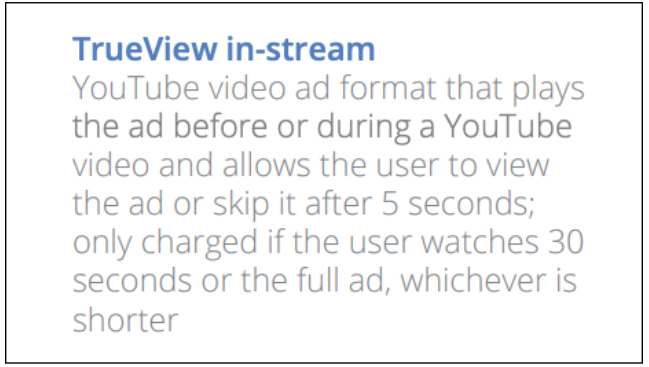
Source: Google
According to a second part of Google’s online documentation, “TrueView in-stream” “ads play before or during another video from a YouTube partner.”
According to a different part of Google’s online documentation:
“TrueView is Google’s proprietary cost-per-view, choice-based ad format that serves on YouTube, millions of apps, and across the web. TrueView gives advertisers more value because they only have to pay for actual views of their ads, rather than impressions.
Viewers can choose to skip the video ad after 5 seconds. If they choose not to skip the video ad, the YouTube video view count will be incremented when the viewer watches 30 seconds of the video ad (or the duration if it's shorter than 30 seconds) or engages with your video, whichever comes first.”
Source: Google
In another part of Google’s online documentation, it is stated that:
“Skippable in-stream ads (formerly called TrueView) appear before, during or after YouTube videos. Viewers are shown the first five seconds, then have the option to 'skip', so the sooner you draw them in and keep them engaged, the better. If a viewer skips before 30 seconds or until duration if it's shorter than 30 seconds, there is no charge”
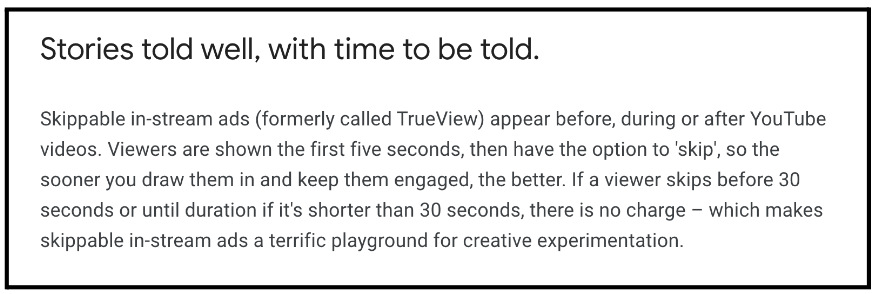
Source: Google
According to a different section of Google’s public online documentation, “TrueView in-stream ads enable advertisers to reach users while they engage with videos aross [sic] YouTube and the Google Display Network. Advertisers only pay when a user chooses not to skip their ad. Because users are given the option to skip the ad, a view will also increment the YouTube video view count.” The documentation states that “Your video ad plays before, during, or after other videos,” and the benefits of this ad include that an advertiser can “Reach and only pay for consumers who have chosen to connect with your brand.”

Source: Google
Furthermore, another section of Google’s public online documentation states: “TrueView and skippable video ads
Google Ads allows advertisers buying on YouTube to extend their budgets to sites and apps that partner with Google, including using our proprietary TrueView format. To be eligible to receive skippable ads, including TrueView ads, these additional policies apply:
Video ad placements must be audible by default.
Scroll-to-play ads are not permitted for TrueView.
For mid-rolls, the video content’s duration must be at least 10 minutes.”
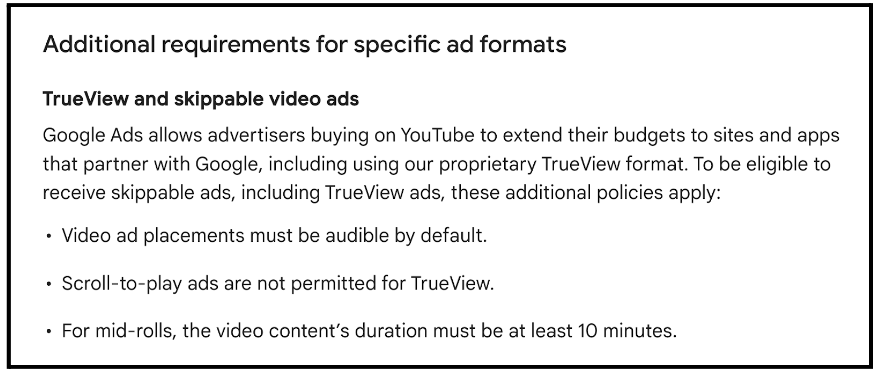
Source: Google
Google’s policies also state that, for publishers utilizing the Google Ad Manager publisher ad server, publishers hosting in-stream video ads must:
“Use metadata and declarations to accurately describe inventory so that advertisers are correctly informed where their ads run.
Video ad placements must either be audible by default or properly declared as a muted placement.
Only serve in-stream video ads to valid in-stream placements, which excludes:
Video slideshows highlighting content available on a site without original video content.
Video ads in a display banner ad on a web page or app.
Video ads in the rail of the page, such as in a 300x250 slot on desktop.
Video ads in placements with no accompanying video content, apart from non-in-stream placements.
Video ads in placements that cycle between display ad units and video ads, whether or not there is accompanying video content.
In-banner video ads which do not load a video player.”
Lastly, Google’s documentation states that “While video ad content must be hosted on YouTube, video ads can appear on YouTube and across websites and apps running on Google video partners”.
To summarize, the key points documented by Google regarding TrueView skippable in-stream ads are:
appear before, during, or after YouTube videos or other video content
video ad content must be hosted on YouTube
the ads can serve on YouTube proper (e.g., the YouTube website youtube.com or the Android and iOS YouTube apps), but they can also serve on “millions of apps” and “across the web”*
for Cost-per-view (CPV), advertisers only pay if the consumer engages with the ad, watches the full ad, or watches 30 seconds of a longer ad**
for CPV, if a consumer chooses to click on the “skip” button before the video ad is over or before 30 seconds, the advertiser does not pay for a “view” of their video ad**
TrueView in-stream ad placements must be audible by default
Scroll-to-play ads are not permitted for TrueView (generally speaking, this means the ads should not “auto-play” when a consumer visits a site or app, but rather, require some form of user initiated action beyond passive scrolling)
* Note that various parts of Google’s public online documentation appear to be unclear. In one page, Google states that YouTube TrueView ads will “appear before, during or after YouTube videos”, with no reference to ads which appear before or after video content other than YouTube videos, such as non-YouTube video content on partner websites. However, other parts of Google’s documentation, state that the “Your video ad plays before, during, or after other videos”, “alongside other videos on YouTube and partner sites and apps”, without reference to whether or not those “other videos” on “partner sites” will be YouTube videos or non-YouTube videos. A third part of Google’s public online documentation states that TrueView in-stream is: “YouTube video ad format that plays the ad before or during a YouTube video and allows the user to view the ad or skip it after 5 seconds.”
** Note that other parts of Google’s public online documentation also appear to have different information about available billing strategies for in-stream TrueView ads. One page in Google’s online documentation states that “You pay when a viewer watches 30 seconds of your video (or the duration if it's shorter than 30 seconds) or engages with your video, whichever comes first.” This page only makes references to the Cost-per-view (CPV) billing model. However another page in Google’s online documentation about “Skippable in-stream ads” makes reference to four different “available bidding strategies”, including Cost-per-view (CPV), Target cost-per-action (CPA), Maximize conversions bidding, and Target cost-per-thousand impressions (tCPM).
What are Google Video Partners (GVP)?
As alluded to earlier, Google makes it clear in its online documentation that TrueView skippable in-stream ads can serve on third party publishers, including “millions of apps, and across the web.” These websites and apps are not necessarily websites or apps that host an embedded YouTube video player. Rather, these are sites that registered with Google as eligible ad inventory partners.
According to Google’s public online documentation,
“Google video partners are high-quality publisher websites and mobile apps where you can show your video ads to viewers beyond YouTube” (emphasis added).
“Video partner publishers are carefully vetted and must meet Google's inventory quality standards. Video partner publishers also need to follow the policies applicable to their ad management platform (which can include Google Ad Manager, AdMob, or AdSense). Our Video Ad Safety Promise, in which certain types of content can't be monetized for ads, applies to both YouTube and Google video partners.” (emphasis added).
According to Google’s public online documentation, “Video partner sites and apps consist of leading publishers in games, sports, entertainment, news, and more.” Google Video Partners are automatically opt-ed in for new TrueView campaigns Since approximately July 2019, certain types of TrueView ad campaigns are opted-in to Google Video Partners by default. For certain types of TrueView campaigns, the media buyer must explicitly opt-out of having their ads delivered to GVP sites and apps, if they wish to only have their video ad served on YouTube.com and the YouTube mobile apps.
Furthermore, certain types of video ad campaigns do not allow the media buyer the option of opting out of GVP sites and apps. Specifically, Google’s online documentation states that “As of September 30, 2021, new Video action campaigns that you create in Google Ads use Google video partners automatically [...] you won’t be able to opt out of Google video partners for Video action campaigns.”
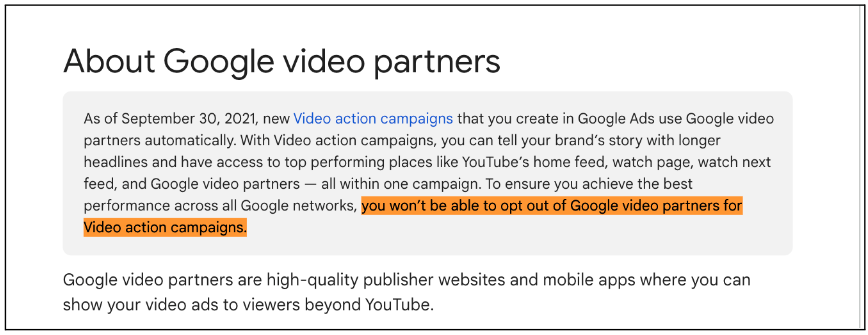
Source: Google

Furthermore, Google’s documentation states that certain TrueView campaigns which previously chose to opt-out of the Google Video Partner network would be automatically opted into buying GVP as of April 25th, 2022.
To summarize, it appears that TrueView media buyers can choose to opt-out of buying on the GVP network for brand awareness and reach campaigns. Media buyers cannot opt out for any other campaign type including TrueView conversion campaigns. It appears the Google Video Partner network is mandatory for TrueView campaigns optimized to a performance goal.
Google Video Partners publishers claim NOT to fully control the insertion of TrueView ads on their websites or apps Multiple publishers interviewed by Adalytics claimed that while they can control the declaration of “in-stream” and “skippable” ad inventory slots on their own websites or apps via their Google Ad Manager dashboards, they do not have direct control over whether a TrueView skippable in-stream ad is inserted into a given ad slot on a website or app. The publishers claimed they can make themselves “eligible” for TrueView skippable in-stream inventory, but it is ultimately Google’s servers which adjudicate when or how often to insert a TrueView ad into a particular ad slot.
What are “in-stream” versus “out-stream” video ads?
According to Google’s public online documentation,
“In-stream ads are ads that are played within the context of a video or audio stream in the same video or audio player that a user is viewing audio or video content.”
Another part of Google’s online documentation states that:
“valid in-stream placements, which excludes:
Video slideshows highlighting content available on a site without original video content.
Video ads in a display banner ad on a web page or app.
Video ads in the rail of the page, such as in a 300x250 slot on desktop.
Video ads in placements with no accompanying video content, apart from non-in-stream placements.
Video ads in placements that cycle between display ad units and video ads, whether or not there is accompanying video content.
In-banner video ads which do not load a video player.”
Furthermore, Google’s documentation states that: “For in-stream ads, the sum duration of video content must exceed the sum duration of video ads.”
Lastly, Google’s public online documentation states that:
“In-stream video typically represents pre-, mid-, or post-roll ads shown within other video content (essentially these ads are blended into the primary video content). [...] Out-stream video is what is typically shown in "display" ads such as banners, interstitials, native (inline) ads, etc (in contrast to in-stream video, which is blended with other video streams).”
According to another piece of Google’s documentation on “Outstream video ad[s]”, outstream video ads “ serve on partner sites and apps outside of YouTube”, and “the ads start with the sound off and the user can tap the ad to unmute it.”
Google’s online documentation states that games are not in-stream video placements
Various parts of Google’s public, online documentation state that games are not considered to be valid in-stream placements. Google’s “Video publisher policy” specifies: “non-instream video placement (for example, games, in-article, in-feed)”.
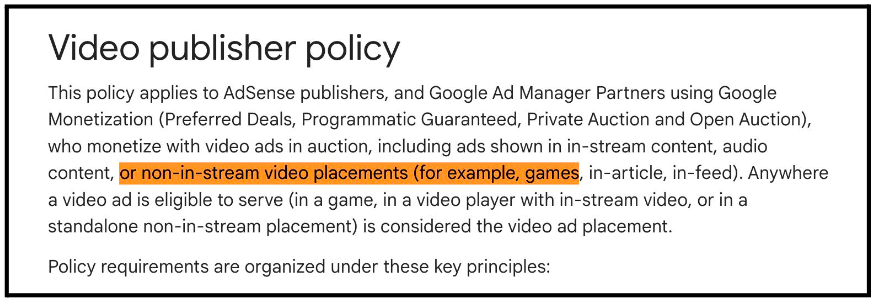
Source: Google
Another part of Google’s documentation states that “non-in-stream video ads, including ads in games”.

Source: Google
Furthermore, a Google article titled “Capture growing video budgets with out-stream video ads”, states that: “Out-stream video ad formats include:
In-feed & In-article — receive video demand (non-native) for display slots centrally positioned in the middle of non-video content, such as news articles and feeds. These formats are supported for mobile web, mobile app, and desktop inventory.
Interstitial ad units — rich, full-page ads in your app. Place them at natural breaks and transitions in your app's interface, such as at launch, after level completion in a gaming app, or after an article view in a news app. These ads are supported for mobile app inventory” (emphasis added).
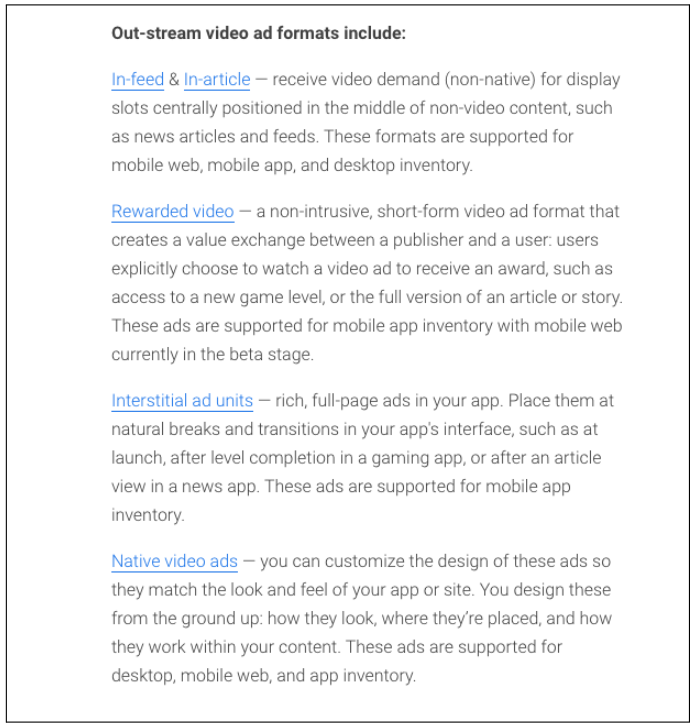
Source: Google
Google’s online documentation states that misrepresentation of in-stream and out-stream video is a form of “invalid traffic”
According to Google’s documentation on the “Definition of invalid traffic”, “Invalid traffic includes any clicks or impressions that may artificially inflate an advertiser's costs or a publisher's earnings. Invalid traffic covers intentionally fraudulent traffic”.
Google’s public online documentation on “What is invalid traffic?”, states that “Misrepresentation of in-stream and out-stream video” is an example of invalid traffic
Specifically, Google’s documentation states that:
“Out-stream video invalid traffic is the misrepresentation and display of in-stream video in an out-stream format. For example, this happens when in-stream video ads are shown in a banner ad -- an advertiser is led to believe that their ad was displayed in-stream with other video content, when in fact it was displayed in a different format.”
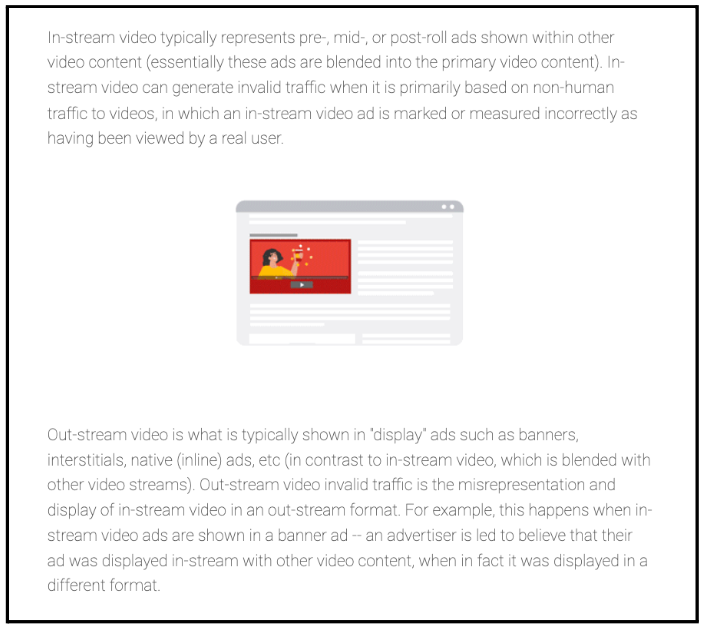
Source: Google
Google’s “Video Ad Safety Promise”
According to Google’s public online documentation,
“Our Video Ad Safety Promise is that certain types of content can’t be monetized for ads on YouTube and Google video partners: we'll automatically apply exclusions to prevent your ads from showing on the most controversial content, such as terrorist acts, nudity, and recent sensitive events.”
The “Video Ad Safety Promise” states that “Your ads automatically will be excluded from showing on the following types of content, no matter what inventory type you choose.”
This list includes, “Content discussing terrorism or sensitive current events like war, death, or tragedy”.
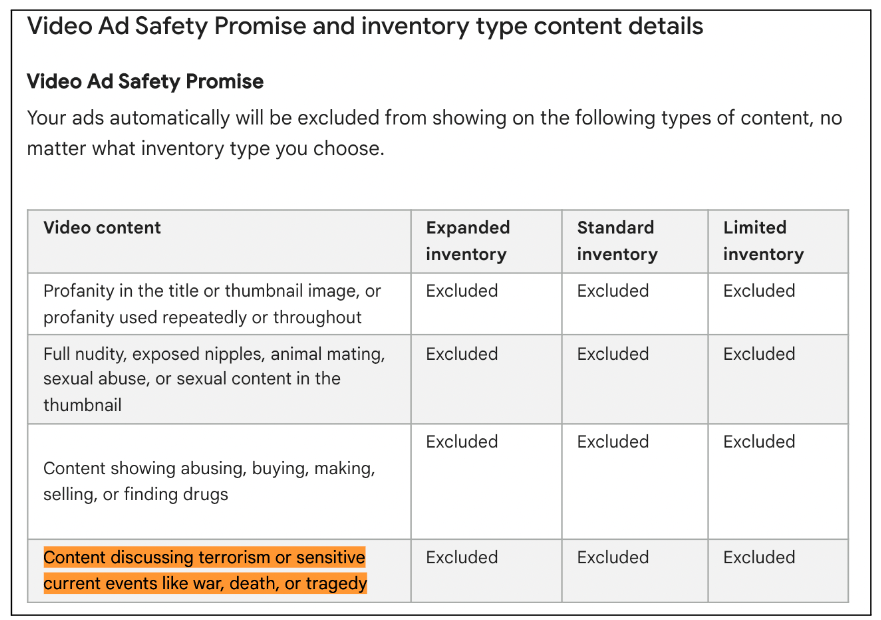
Source: Google
Does YouTube allow independent measurement & verification of ad placements?
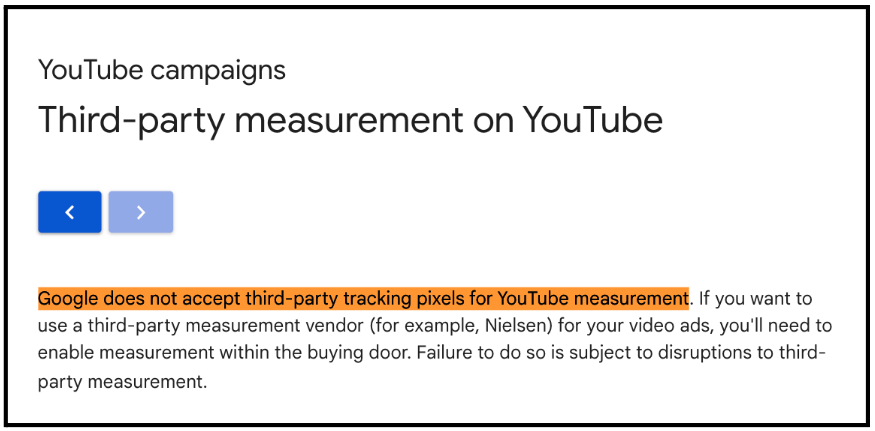
Screenshot from Google’s public online documentation
According to Google’s public online documentation on “Third-party measurement on YouTube”, “Google does not accept third-party tracking pixels for YouTube measurement.”
YouTube does have a YouTube Measurement Program (YTMP), which includes ad verification companies like Integral Ad Science (IAS) and DoubleVerify. However, it appears that these measurement partners have to rely on aggregated, server-to-server data transfers - via the “YouTube data feed” in order to execute their “independent” measurement analytics. The vendors are not able to place their own, independent pixels or code directly into the YouTube ad serving environments.
The distinction is important, as it means the YouTube Measurement Program partners are likely not able to independently verify or measure the environments in which the YouTube ads are appearing. Rather, these measurement vendors likely must rely on data that YouTube itself collects and then makes available to them.
It is not clear whether or not the YTMP vendors are given access to information on YouTube video ads serving on the Google Video Partner (GVP) network at all.
In 2020, the Wall Street Journal (WSJ) reported that “Google wants to substantially limit the information a key auditor of YouTube can share about the risks of advertising on the video service”. WSJ wrote that an auditor “is refusing to sign a contract that would prevent it from reporting to clients when ads have run in videos with sensitive subject matter, including hate speech, adult content, children's content, profanity, violence and illegal substances, according to an email the firm sent over the weekend to ad agencies.”
Prior brand safety concerns regarding YouTube ad inventory
There have been dozens of documented news articles about how YouTube has allowed major brands’ ads to serve (and possibly, fund) videos from terrorist organizations or beheadings.
In March 2015, NBCNews reported that
“Several major U.S. companies were apparently caught unaware that ads featuring their products were playing before Islamic State-related videos recently uploaded to YouTube. Proctor & Gamble, Toyota and Anheuser-Busch were among the companies with pre-roll ads running before videos associated with the militant Islamist group, also known as ISIS or ISIL”
In February 2017, The Times of London reported that many mainstream brands were unwittingly funding white supremacists and Islamic extremists by advertising alongside their videos. The Times article stated that: “Advertisements for hundreds of large companies, universities and charities, including Mercedes-Benz, Waitrose and Marie Curie, appear on hate sites and YouTube videos created by supporters of terrorist groups such as Islamic State and Combat 18, a violent pro-Nazi faction.”
The Times reported that, “Sandals Resorts, the luxury holiday operator, is advertised next to a video promoting al-Shabaab, the East African jihadist group affiliated to al- Qaeda. Last night a Sandals spokeswoman said that it made “every effort” to stop its adverts appearing next to inappropriate content. It said that YouTube had “not properly categorised the video” as sensitive.”
Furthermore, the Times article states that British Members of Parliament “called on Google to explain why hundreds of extremists were making money from advertising on YouTube.”
Marc Pritchard, the top marketer at Procter & Gamble Co., told the CEO of YouTube in 2018 “You went to a large galaxy that was beyond what anyone had ever seen [...] And I don’t think you’ve realized the impact you’ve had.”
In 2018, a CNN investigation found “ads from over 300 companies and organizations — including tech giants, major retailers, newspapers and government agencies — ran on YouTube channels promoting white nationalists, Nazis, pedophilia, conspiracy theories and North Korean propaganda.”
“Companies such as Adidas, Amazon, Cisco, Facebook, Hershey, Hilton, LinkedIn, Mozilla, Netflix, Nordstrom and Under Armour may have unknowingly helped finance some of these channels via the advertisements they paid for on Google-owned YouTube.”
“U.S. tax dollars may have gone to the channels, too. Ads from five U..S government agencies, such as the Department of Transportation and Centers for Disease Control, appeared on the channels.”
“Many of the companies that responded to CNN said they were unaware their ads had been placed on these channels and were investigating how they ended up there.”
“Ads from the Washington Post and New York Times appeared on far-right and conspiracy channels like Black Pigeon Speaks and some run by InfoWars.”
"It appears that YouTube did not follow its own protocols and categorize these videos properly," the New York Times told CNN. The paper said its ads should only appear on a list of pre-approved sites. If the channels are monetized -- which InfoWars has previously claimed they are -- the major newspapers could have unknowingly supported disinformation and conspiracy.” YouTube is Media Ratings Council (MRC) and Google is TAG accredited for brand safety YouTube received “content-level brand safety accreditation” from the Media Rating Council. Furthermore, Google is (as of May 2023) enrolled in the Verified by TAG program, and has achieved a “Brand Safety Certification” seal. The Trustworthy Accountability Group (TAG) is a “certification program” that was “created by the American Association of Advertising Agencies (4A's), Association of National Advertisers (ANA), and Interactive Advertising Bureau (IAB).”
The declared purpose of the TAG Brand Safety Certification is “to significantly reduce the risk of the misplacement of advertising on digital media properties of all types, thereby upholding Brand Safety and protecting the integrity of digital advertising.”
TAG’s Brand Safety Certification states that any participating company acting as a seller or intermediary must:
disclose “staff and/or tools/technology used to review and/or flag content as brand safe”
disclose “staff and/or tools/technology used to review or flag content disclosing from media properties associated with piracy.”
“must employ pirate mobile app filtering for all advertising displayed in a mobile app environment.”
“A participating company acting as a direct buyer, intermediary, vendor or seller should employ a TAG-recognised content taxonomy for harmful content” and “Digital advertisements may not be displayed in association with any content categories” such as “Online Piracy”, “Sensitive Social Issues”, “Death Injury or Military Conflict”.
Research methodology
This research study relied on several independent sources of data to analyze the placement and audio-visual media quality of various TrueView skippable in-stream ads, as well as to assess marketers expectations about those ad placements.
Adalytics used a variety of open-source data sources, as well as logs from DeepSee.io’s ad-quality crawlers, to create a list of Google Video Partners whose video ad serving experience is inconsistent with Google’s public written policies, such as out-stream video players that are muted, auto-playing or not visible to the consumer. This exclusion list identified tens of thousands of websites and mobile apps which, for a combination of reasons, do not appear to be consistent with the TrueView in-stream ad format.
Secondly, Adalytics used the assembled “exclusion list” of ineligible Google Video Partner publishers, and compared this list against TrueView ad buy placement reports from advertisers, including Fortune 500 brands’ TrueView skippable in-stream campaigns. This analysis was performed to determine:
How much of each brands’ TrueView in-stream budget went to YouTube.com, versus third party GVP sites and apps?
Of the ad budget budget that was delivered against GVP sites and apps, how much of that budget was delivered against sites or apps that are not consistent with the TrueView in-stream ad format?
Lastly, Adalytics surveyed several dozen media buyers from brands and media agencies to determine whether the observed placements were consistent with their expectations for TrueView skippable in-stream campaigns. Use of open-source intelligence and digital forensics Adalytics isolated several open-source intelligence (OSINT) selectors that can be used to identify when Trueview skippable in-stream video ads are being served on a consumer’s browser or phone. These are digital forensics signatures or “breadcrumbs” that can be utilized to ascertain whether a given video ad serving on a viewer’s personal device is coming from YouTube, and whether that video ad is a TrueView skippable in-stream ad. Digital forensics to identify TrueView skippable in-stream video ads
When a TrueView skippable in-stream video ad is delivered to a consumer’s device, the ad creative source code returned from Google’s servers contains several specific signatures.
A publisher, such as foxnews.com or huffpost.com, configures the Google Publisher Tag or Google Mobile Ads SDK, a piece of code, to initiate HTTPS requests to Google’s servers to return ads from Google Ad Manager or Adsense. Any consumer or member of the public can view these sequence of some of these HTTPS requests by opening a browser’s developer tools, switching to the “Network” tab, and filtering for HTTPS requests being sent to an endpoint such as “securepubads.g.doubleclick.net/gampad/ads”. When video ads are fetched, these HTTPS requests will often contain the query string parameter “output” set to the value of “xml_vast4”. VAST (Video Ad Serving Template) is a “VAST is a specification defined and released by the Interactive Advertising Bureau that sets a standard for communication requirements between ad servers and video players in order to present video ads.
Screenshot showing Chrome Developer Tools’ “Network” tab open on a German website. The developer tools are filtered for HTTPS requests from the consumer’s browser going to doubleclick.net to fetch a video VAST ad.
Sometimes, but not always, the HTTPS request sent to “securepubads.g.doubleclick.net/gampad/ads” will return a video ad creative to serve. In a subset of occasions, that video ad creative VAST file will include references to the video file being a “YouTubeHostedAd”, including the “YouTubeVideoId”. One can copy the “YouTubeVideoId” and use it to find the original video on YouTube.com. Usually (but not always), these video ads are marked as “unlisted” in both the video ad and on YouTube.com. This means the given video will not appear in YouTube.com search results or by checking a given YouTube channel’s public list of videos.
For example, the screenshot below from a consumer’s Chrome Developer Tools’ Network tab shows a video VAST ad creative being served, on behalf of the travel brand Vrbo (which is owned by Expedia Group). One can see that the Vrbo video ad is marked as a “YouTubeHostedAd”, and that the “YouTubeVideoId” is equal to “x4iwq6cH-Bg”. If a consumer copies that ID value and appends it to the URL “https://www.youtube.com/watch?v=”, they can find and view the unlisted Vrbo video. This Vrbo video is listed at https://www.youtube.com/watch?v=x4iwq6cH-Bg (archived link here).
Screenshot of Chrome Developer Tools Network tab on de.investing.com, a German language website. The screenshot shows a video VAST ad creative file for the travel brand Vrbo, and there are references to the video being a YouTube hosted ad. The YouTube Video ID is “x4iwq6cH-Bg”.
Screenshot of a Vrbo YouTube video which served as a TrueView video ad on de.investing.com. The Vrbo video is marked as “Unlisted” on youtube.com. The YouTube Video ID is “x4iwq6cH-Bg”.
The significance of the “YouTubeHostedAd” label in the source code of these video ad files is that, (according to Google’s public online documentation), while “video ads can appear on YouTube and across websites and apps running on Google video partners”, the “video ad content must be hosted on YouTube” (emphasis added). In other words, even if a YouTube video ad is being served on a 3rd party apps such as huffpost.com or dostor.org, the video ad itself must be uploaded by the advertiser to YouTube first.
For a select subset of video ad VAST creatives that are labeled as a “YouTubeHostedAd”, the video ad source code will also include references to several parameters which seem to indicate that the ad is being run as part of a TrueView campaign.
Specifically, some video VAST tags include the parameter “IsTrueView”, which can be set to either “true” or “false”, and the parameter “format”, which can be set to “TRUEVIEW” or other possible values such as “SKIPPABLE” or “BUMPER”.
Screenshot of a Consumer Cellular YouTube video which served as a TrueView video ad on lebanonfiles.com. The video ad file is marked as “IsTrueView” = “true” and “format” = “TRUE”
The video VAST tags often also include other useful information, such as the “VisibleUrl” field which details for which brand or advertiser the given YouTube video ad is for.
The VAST tags also include references to a conditional event called “instreamAdComplete” and “skip’, which appear to trigger if and when an instream video is watched to completion and when a consumer decides to skip a video ad before it finishes running (respectively).
Furthermore, when one of these YouTube-hosted TrueView ads renders on a consumers device, the browser or mobile app will send out various event tracking HTTPS requests to the endpoint pagead2.googlesyndication.com, with a query string parameter called evt (“event”) which can be set to values such as “start”, “showui”, “skip”, or “complete”. These HTTPS requests will occasionally include a parameter for format, which can be set to “TRUEVIEW”.
Screenshot of Chrome Developer Tools’ Network tab, showing an HTTPS request sent to the endpoint ‘pagead2.googlesyndication.com’, with the query string parameter “format=TRUEVIEW”
To summarize, there are a number of informative digital forensics identifiers that can be used to identify when YouTube TrueView ads are served on websites or apps based on HTTP network traffic data.
These include:
HTTPS requests where the referer request header is “imasdk.googleapis.com” (the Google IMA SDK video player), that were sent to the endpoint “pubads.g.doubleclick.net/gampad/ads”, with the query string parameter “output” set to “xml_vast”, where the response is a video VAST tag that contains the strings “<format>TRUEVIEW</format>” and “<IsTrueView>true</IsTrueView>”
HTTPS requests where the referer request header is “imasdk.googleapis.com”, that were sent to “pagead2.googlesyndication.com/pagead/gen_204?evt=start”, where the query string parameter “format” is set to “TRUEVIEW”
Filtering for muted and auto-playing video player HTTPS requests sent to Google Ad Manager
Many publishers utilize Google’s publisher ad server - known as Google Ad Manager (GAM) to serve ads on their websites and apps. Many of the publishers also utilize the Google Interactive Media Ads (IMA) software development kit (SDK) to integrate multimedia ads into their websites and apps.
Google Ad Manager allows publishers to traffic video line items and video creatives that request video assets via the Video Ad Serving Template (VAST). A VAST ad tag URL is used by a player to retrieve video and audio ads. According to Google’s online documentation, while “Ad Manager's main responsibility is to serve the VAST that contains the video media files, third-party VAST, tracking metrics, and so forth, it's not part of any additional processes once the VAST is delivered to the requesting source.”
“IMA SDKs can request ads from any VAST-compliant ad server and manage ad playback”.
In layman’s terms, one could say that the GAM software is responsible for getting the video ad code from Google’s servers, while the IMA SDK actually renders the video and the associated play, mute, and pause buttons. The VAST tag contains the code instructions for the specific video ad.
Google’s Ad Manager public documentation defines specific parameters which publishers can configure when sending requests to Google’s servers for specific video or audio ads. For example, an app or website publisher can configure a parameter called “afvsz”, which encodes the “ad sizes that can be displayed in the video ad slot.” There are two parameters that are of particular significance with regards to the delivery of YouTube video ads on Google Video Partner (GVP) sites and apps.
The first is a GAM parameter called “vpmute”, which stands for “Video play mute”. Google’s online documentation states that “The muted video parameter accepts a constant value which indicates whether the ad playback starts while the video player is muted.” If “vpmute” is set to “1”, this means the the video player is muted, while if “vpmute” is set to “0”, it means the video player where the video ad will serve is unmuted (audible).
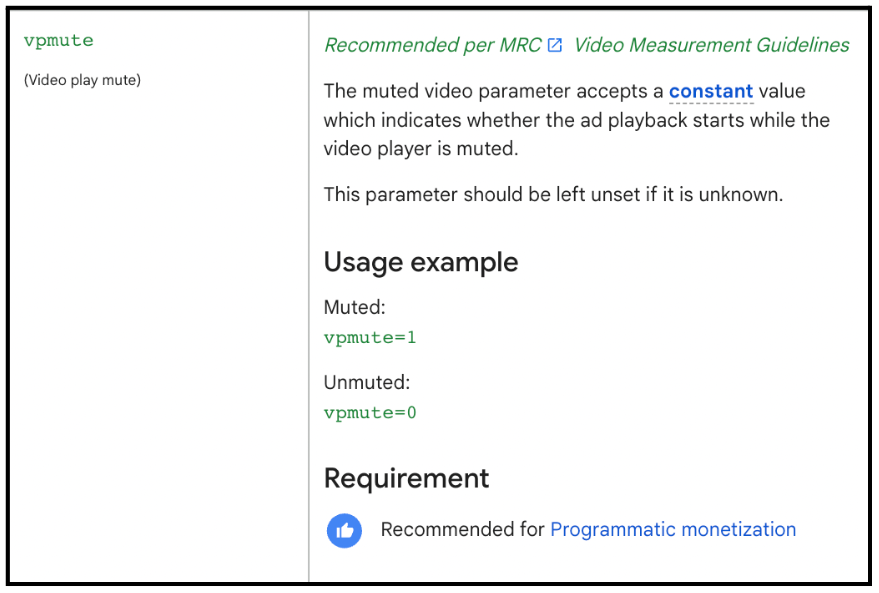
Screenshot of Google’s online documentation for Google Ad Manager, showing the definition of the “vpmute” parameter.
The second Google Ad Manager parameter of interest is “vpa”, which stands for “video play automatic”. According to Google’s online documentation, “The video play automatic parameter accepts a constant value which indicates whether the ad starts through autoplay or click. Possible values are click if the page waits for a user action or auto if the video plays automatically.” The “vpa” parameter can be set to “auto”, which means the video will “autoplay”, or “vpa” can be set to “click”, which means the video is “click to play” (e.g., the user has to click to initiate video playback).
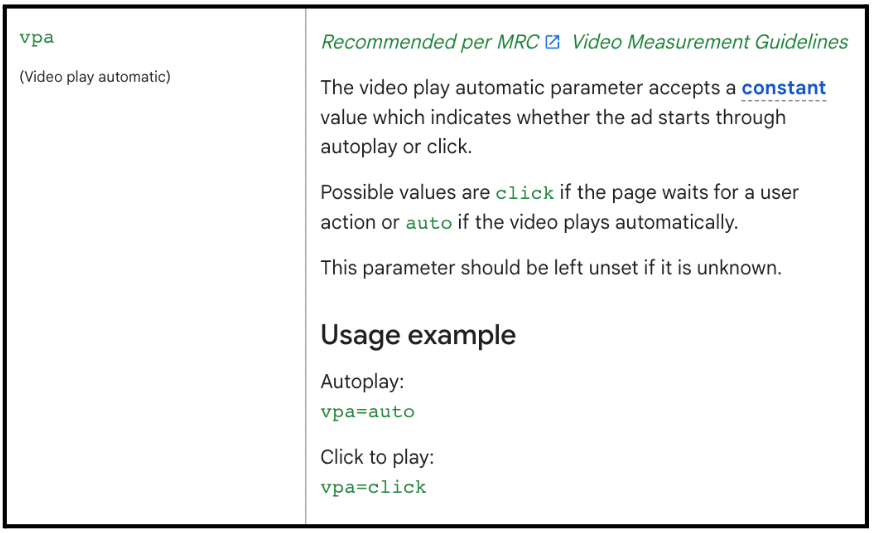
Screenshot of Google’s online documentation for Google Ad Manager, showing the definition of the “vpa” parameter.
These two Google Ad Manager parameters which are sent to Google’s servers when a publisher requests a video ad are significant in how they relate to the delivery of YouTube TrueView video inventory. As discussed in a previous section of this report, Google’s public online documentation specifically states that for YouTube TrueView video ads, “Video ad placements must be audible by default” and that “Scroll-to-play ads are not permitted for TrueView.”
This suggests that Google’s servers should never serve a YouTube TrueView ad if the “vpmute” parameter is set to “1” or if the “vpa” parameter is set to “auto”, as such conditions would be incompatible with the required specifications for YouTube TrueView ads.
Filtering for muted YouTube video ads
As mentioned before, TrueView ads are a type of YouTube ad, and they generally serve via Google’s IMA SDK when rendered on third party websites and apps that are part of the Google Video Partner network.
When a consumer watches a video ad on youtube.com, their browser records several metrics and relays those metrics to YouTube’s servers.
One of these metrics is the volume setting of the consumer’s browser. In the screenshot below, one can observe a YouTube video ad serving on behalf of the food delivery company GrubHub. This video ad is serving with the consumer’s audio button on YouTube.com set mid-way along the slider scale. On the right of the screen, the consumer can observe their browser making HTTPS requests to YouTube’s servers, recording that the volume player state at that moment was set to “43”, out of a potential scale of 0 to 100.
Screenshot showing a YouTube ad playing, with the “volume” query string parameter recorded as being set to “43”, out of a scale of 0 to 100. Similarly, when YouTube hosted video ads serve on 3rd party GVP sites and apps, one can also observe HTTPS requests being sent to YouTube’s servers showing the volume state set to a value between 0 (muted) and 100 (maximum volume).
Screenshot of a YouTube TrueView ad for elegentthemes.com serving on dostor.org, showing the “volume” query string parameter set to zero as the video plays in a completely muted state
These YouTube API HTTPS requests serve as an additional useful selector to identify YouTube video ads serving in a muted state on third party sites. The specific selector in question is:
HTTPS requests where the referer request header is “imasdk.googleapis.com” (the Google IMA SDK video player), that were sent to the endpoint “youtube.com/api/stats”, with the query string parameter “volume” set to “0”
Searching through internet archives
Using the aforementioned digital selectors and identifiers, several public and private web browsing archives were searched for instances where YouTube TrueView video ads were served on Google Video Partner (GVP) publishers. These archives include instances of crawlers or emulators scanning various online environments, and recording all the data that was sent over each respective automated browsers’ network layer.
For example, HTTP Archive uses an automated Chrome desktop or emulated Android mobile bot to crawl millions of URLs monthly. The crawlers gather metrics and data about the browsing experience on each page. HTTP Archive’s test agents are run from Google Cloud data centers across the US. The HTTP Archive collects these HAR files, parses them, and populates various tables in BigQuery, where one can then search through the HTTP request data to identify instances of YouTube TrueView ads being delivered to bots. HTTP Archive has crawl data going back many years, since at least 2016.
The archives analyzed in this research study included:
The HTTP Archive
Crawler data from publisher quality intelligence vendor DeepSee.io
As another example, a user can use the URLScan.io (a cybersecurity headless chrome crawler service) to search for page captures where the page the crawler visited sent out HTTPS requests to “https://pagead2.googlesyndication.com/pagead/gen_204”, with the “format=TRUEVIEW” query string parameter.
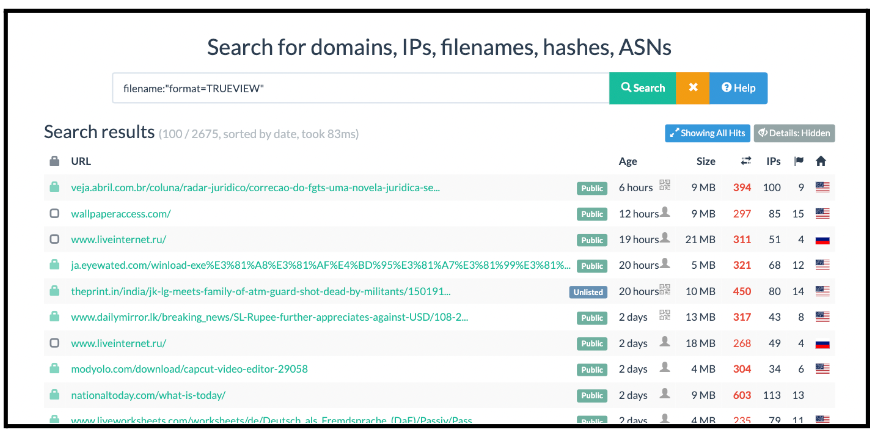
Screenshot of URLScan.io, showing a search for any page crawls where there was an HTTPS request with the query “format=TRUEVIEW”.
There appear to be thousands of instances where YouTube TrueView ads were served to the URLScan.io bot.
Furthermore, one can analyze each identified URLScan.io crawl session and filter for HTTPS requests that were sent to the Google Ad Manager endpoint “pubads.g.doubleclick.net/gampad/ads”, where there is a query string parameter “output=xml_vast4”. One can then analyze the VAST tag that Google’s serves returned to the URLScan.io bot. For example, in the screenshot below one can see that on April 12th, 2023, URLScan.io’s bot crawled a Brazilian website “veja.abril.com.br” from a German IP address. The bot was served an 89 KB VAST video ad.
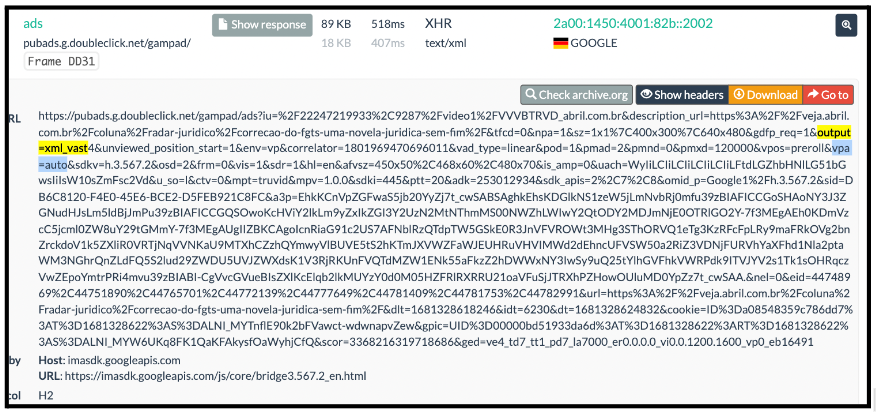
Screenshot of an HTTPS request sent to Google Ad Manager during a URLScan.io crawl of a Brazilian website on April 12th, 2023
One can then analyze the response sent back from Google’s ad servers (specifically, the 89 KB video VAST ad code). The VAST tag shows the ad is for YouTube video ID “NlTwtaNN6QU”, which is a video for the freelancer hiring platform Fiverr (https://www.youtube.com/watch?v=NlTwtaNN6QU). Furthermore, analysis of the VAST tag’s “VisibleUrl” field confirms the video ad served to the URLScan bot on April 13th on the Brazilian website was for “de.fiverr.com” (Fiverr’s German sub-domain).
Screenshot of an 89 KB VAST tag served to a URLScan.io crawler, showing that the Visible for the video ad is for “de.fiverr.com”
Of particular interest in this analysis is the fact that the HTTPS request sent to GAM to retrieve this Fiverr video ad creative contained the query string parameter “vpa=auto”. As discussed earlier, this query string parameter indicates that the video player where the ad will render will play automatically, without the page waiting for user action. As discussed in the Background section of this report, Google’s public online documentation explicitly states that “Scroll-to-play ads are not permitted for TrueView.” It is not clear why the Google Ad Manager servers returned a YouTube TrueView ad for Fiverr, even when the servers were explicitly informed that the video player auto-plays without user action.
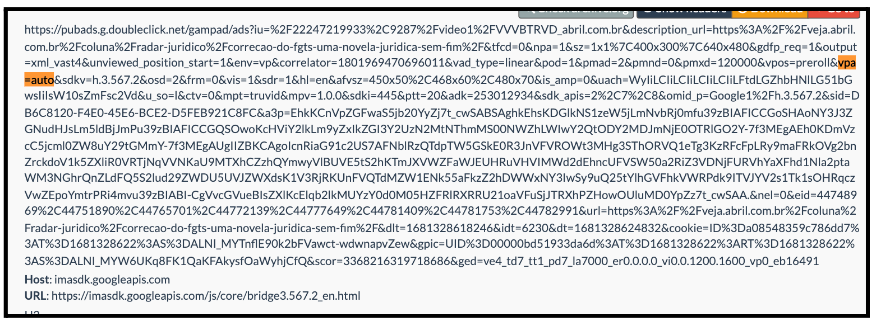
Screenshot of an HTTPS request sent to Google Ad Manager to retrieve a Fiverr ad for URLScan.io’s bot during a crawling session. The screenshot highlights that the query string parameter is set to “vpa=auto”.
Screenshot of an HTTPS request sent to Google Ad Manager to retrieve a Fiverr ad for URLScan.io’s bot during a crawling session. The screenshot highlights that the query string parameter is set to “vpa=auto”.
As another example, one can observe a YouTube TrueView subscription campaign ad for the Financial Times serving on newsmax.com to a URLScan.io bot. The ad buy was handled by Brainlabs Digital, a certified Google Premier partner media agency.

Screenshot of a Financial Times YouTube TrueView ad serving on newsmax.com to a URLScan.io crawler bot, where the video player is playing fully muted.
Careful analysis of the HTTP network traffic recorded by URLScan.io bots when crawling newsmax.com shows that the Financial Times YouTube TrueView ad was served with volume set to “0”.

HTTPS requests sent to youtube.com/api/stats, where “volume=0”, while a Financial Times TrueView ad was served on newsmax.com to URLScan.io’s bot
Publisher environment analysis
Using data from the aforementioned page archives, as well manual inspection using Google Chrome on desktop or mobile apps on Android and iOS, thousands of publishers were evaluated for a number of parameters, including:
Do the video players where the YouTube TrueView ads render auto-play?
Do the video players where the YouTube TrueView ads render play muted?
Are the video players where the YouTube TrueViews render run in small or out-stream video players, rather than in-stream video players?
Is there video content in between consecutive video ads?
Are the “Skip” buttons for TrueView ads visible to the consumer?
What is the volume and density of YouTube video ads served?
Are TrueView in-stream ads being served on games, which Google’s documentation defines as not in-stream?
The goal of this analysis was to determine which Google Video Partner publishers were able to serve valid TrueView in-stream placements. For example, some websites and apps, like video streaming sites viki.com, crunchyroll.com, rumble.com, or mtv.com have video viewing experiences that are audible, user initiated, the focus of the consumer’s attention, with large quantities of organic video content for consumption. These publishers were considered to be consistent with Google’s public documentation on requirements for TrueView in-stream ads.
Other websites and apps, though, may display TrueVideo ads that are muted, auto-playing, out-stream, and serving partially or fully non-visible ads. Some of these websites or apps only have gaming content, and no organic video media streaming.
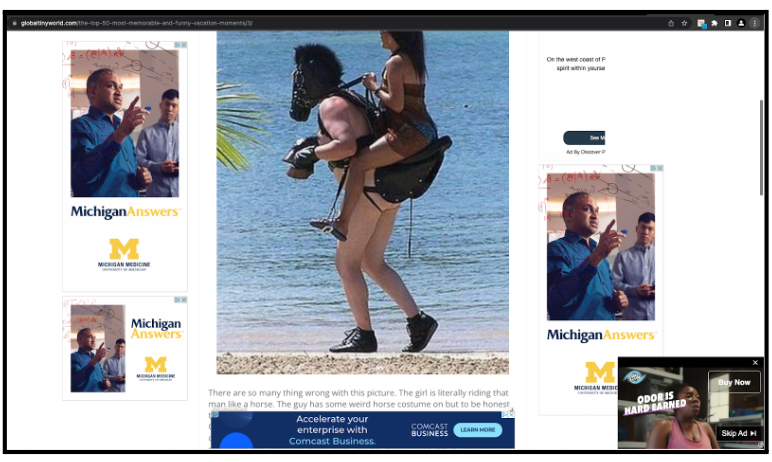
Example of a OxiClean YouTube TrueView ad serving in a muted, auto-playing video player which was considered as not consistent with Google’s published requirements for in-stream TrueView placements
For some fringe publisher cases, there was a combination of both valid and invalid TrueView placements. For example, the website of the New York Times (nytimes.com) had both valid TrueView in-stream ad placement as well as invalid placements. In the screenshot below, one can observe an Adobe YouTube TrueView ad serving in a valid in-stream placement on nytimes.com/video.
Example of a valid in-stream, audible TrueView placement on nytimes.com/video section
However, on other pages, a consumer will come to visit the nytimes.com website to read an article, and will be faced with a subscriber paywall. Even though the consumer cannot actually see the video ad that is serving on nytimes.com, their browser will fetch, serve, and play a YouTube TrueView ad, fully muted. The consumer has no option or choice to skip the TrueView ad, as the entire ad is not accessible to the consumer because of the blocking subscriber wall on nytimes.com.
Screenshot of a YouTube TrueView ad for realtor francacarbone.com serving on “https://www.nytimes.com/2022/03/21/us/politics/ketanji-brown-jackson-confirmation-hearings.html”, wherein the consumer is unable to skip or unmute the TrueView ad. This ad placement is not consistent with Google’s published requirements for TrueView in-stream video ads.
Google’s placement reports for TrueView campaigns do not delineate the exact page URL, section, or sub-domain on which a TrueView ad is rendered upon. It's also not possible for advertisers to only target the legitimate inventory for sites with some combination of valid & invalid in-stream inventory. Given these Google-imposed limitations, this research study classifies publishers like these to be ineligible for TrueView in-stream ads as a whole.
Placement reports from brands buying YouTube TrueView skippable in-stream video ad campaigns
Several major advertisers, including Fortune 500 brands, provided Adalytics with access to placement reports from their YouTube TrueView campaigns, where the media buyer had not opt-ed out of having YouTube TrueView skippable in-stream ads serve on the Google Video Partner network. These reports included information about how many YouTube TrueView video ads delivered on YouTube.com channels, versus third party apps and websites in the Google Video Partner network. These reports included data about the number of views per video ad and how much ad budget was allocated to each publisher or YouTube channel.
The reports were cross referenced against the list of publisher domains and apps that were previously determined to be in-eligible for valid TrueView in-stream placements. The goal of this analysis was to determine how much budget was being allocated to valid 3rd party GVP apps and websites, versus other websites or apps whose video ad serving experience is not consistent with the TrueView in-stream standard.
Surveying marketers and advertisers to assess expectations
Upon identifying a large number of publisher environments that did not appear to be consistent with the requirements for running YouTube TrueView ads on the Google Video Partner network, Adalytics surveyed a convenience sample of marketers, media buyers, and other digital advertising professionals, to assess their expectations with regards to YouTube TrueView ads.
This sample included buyers from multiple countries, buyers from both large media agency holding companies and smaller independent agencies, and media professionals from Fortune 500 brands.
The survey asked questions concerning what marketers expect when buying YouTube TrueView ads. Furthermore, the survey also showed specific YouTube TrueView ad placements on Google Video Partner 3rd party environments, and asked the marketers to comment on whether or not they would consider a given placement to be a valid environment for YouTube TrueView ads.
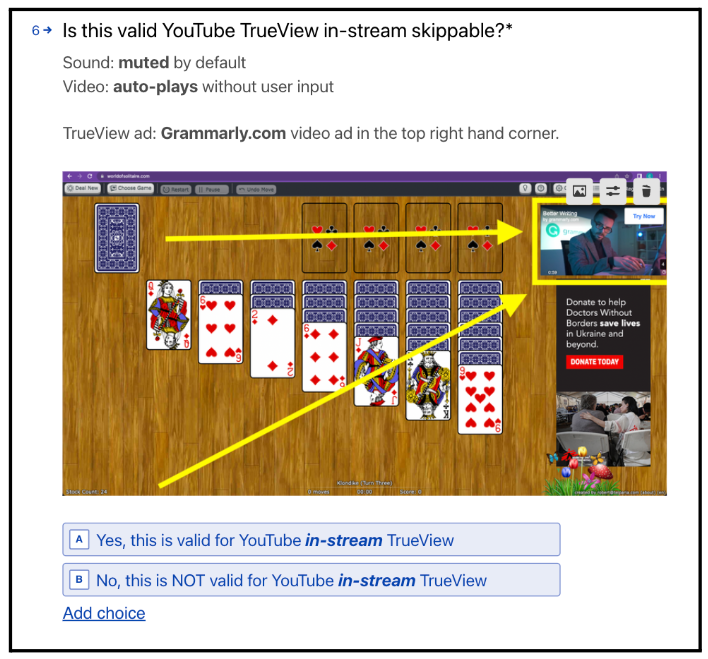
Screenshot of a question from a Typeform survey Adalytics, illustrating an example question that was posed to media buyers about YouTube TrueView ads
Results
In some YouTube TrueView in-stream campaigns, 50-90% of a brand’s YouTube ad budget is spent on third party GVP publisher sites and apps
As discussed in the Methodology section, Adalytics was provided access to YouTube TrueView skippable in-stream ad buy placement reports and data from multiple large brands, including Fortune 500 advertisers. Each ad campaign placement report was analyzed to see how much budget was spent serving ads on YouTube channels (e.g., the YouTube.com website or YouTube iOS and Android mobile apps), versus Google Video Partner third party websites and apps. For one Fortune 500 brand which spent tens of thousands of dollars on a particular TrueView skippable in-stream campaign, almost 90% of the campaign budget went to Google Video Partner (GVP) mobile apps and websites. Only ~10% of the TrueView campaign budget was delivered against YouTube channels.
In another instance, a major consumer goods brand spent over $75,000 on a TrueView skippable in-stream campaign. 20% of the brand’s TrueView campaign budget was delivered against YouTube channels, while 80% was delivered against third party apps and websites such as “investing.com”, “fandomwire.com”, or Candy Crush Saga on Android. There were over 8,000 unique websites and over 5,000 unique mobile applications in the placement report.
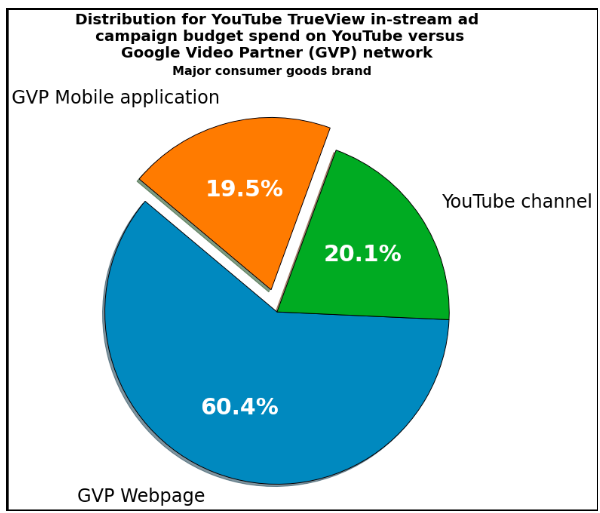
A major infrastructure vendor spent close to several hundreds of thousands of dollars on TrueView skippable in-stream ads campaign over a multi-quarter period. Approximately 15% of the brand’s TrueView budget was spent on YouTube Channels, while the remaining 85% was allocated to GVP third party mobile applications and websites, such as “poki.com” or the “Happy Color: Coloring Book” Android mobile app. There were over 10,000 unique websites and over 8,000 unique mobile apps in this placement report.
Another Fortune 500 brand had approximately 57% of their TrueView in-stream ad campaign budget delivered against Google Video Partner mobile applications and web pages.
In some TrueView skippable in-stream campaigns, 42-75% of a brand’s TrueView ad budget is spent on invalid GVP sites and apps
The previous section detailed how much of some TrueView skippable in-stream video ad campaigns were served against mobile apps and websites in the Google Video Partner network. This section goes a step further, and summarizes how much of that spend on GVP sites and apps was inconsistent with Google’s policies and requirements for TrueView or in-stream video ads. The detailed sub-analyses that went into this summary are detailed in follow-on sections.
As described earlier, Google’s policies state several requirements for TrueView or skippable in-stream ads:
video ad placements must be audible by default
scroll-to-play ads are not permitted for TrueView
Only serve in-stream video ads to valid in-stream placements
valid in-stream placements exclude “out-stream” or “non-in-stream” video slots, such as:
placements with no accompanying video content
games, in-article, or in-feed placements
For one major infrastructure brand approximately 73% of their TrueView skippable in-stream budget was spent on Google Video Partner sites or apps whose ad delivery does not appear to be consistent with the TrueView or in-stream requirements. For example, this brand’s TrueView ads were serving in muted out-stream video players or on games for children with no video content. The brand had hundreds of thousands of TrueView in-stream video ads served into muted, out-stream video slots on mapquest.com, newsmax.com, or factinate.com. The brand also had tens of thousands of TrueView in-stream ads served on the “My Talking Tom 2”, a gaming app “targeted towards kids 4-8” years old.
A major consumer goods brand had 75% of their TrueView budget delivered against Google Video Partner (GVP) sites or apps. 56% of their total TrueView budget was spent against websites which served TrueView ads in muted or non-in-stream video players, such as accuweather.com or heraldweekly.com. 19% of their TrueView skippable in-stream ad budget delivered against in-eligible mobile apps which are not video streaming apps, such as the “Words with Friends Word” mobile app.
A Fortune 500 brand had approximately 57% of their total TrueView in-stream ad budget served on GVP sites and apps. 35% of their total TrueView budget was spent against websites which served TrueView ads in muted or non-in-stream video players, such as citationmachine.net. 8% of their TrueView skippable in-stream ad budget delivered against in-eligible mobile apps which are not video streaming apps.
Analyzing Google Video Partner (GVP) websites
TrueView ads are served on thousands of publishers with muted, out-stream, below-the-fold, or auto-playing video players
As discussed previously, Google’s online public documentation states that TrueView in-stream ads “must be audible by default”, that “scroll-to-play ads are not permitted for TrueView”, and these ads should “only serve in-stream video ads to valid in-stream placements”.
Furthermore, Google’s online documentation states that mis-declaring out-stream video ad slots as in-stream is a form of “invalid traffic.”
As mentioned in the Methodology of the section report, thousands of Google Video Partner publishers were analyzed to determine whether the video ad serving experience on these sites and apps is consistent with the TrueView in-stream ad format. This analysis was partially based on millions of web crawls from sources such as HTTP Archive, DeepSee.io, and URLScan.io. This methodology was used to assemble an exclusion list of publishers who arguably should not be eligible to serve TrueView in-stream ads, in accordance with Google’s published requirements.
The analysis was predicted on a combination of different technical indicators and signals, such as:
observed recordings of HTTPS requests sent to “securepubads.g.doubleclick.net/gampad/ads” (Google Ad Manager), wherein the vpa parameter was to set “click” or the “vpmute” parameter was set to “1”
HTTPS requests where the referer request header is “imasdk.googleapis.com” (the Google IMA SDK video player), that were sent to the endpoint “youtube.com/api/stats”, with the query string parameter “volume” set to “0”
Multiple IMA SDK video players rendering TrueView ads simultaneously
Declaration of video inventory as out-stream by publishers, or muted, auto-played
The research analysis revealed instances of TrueView ads being delivered on websites and apps whose video serving experience was completely consistent with the TrueView format. For example, there were TrueView ads delivered against websites such as the following:
viki.com
crunchyroll.com
rumble.com
dingit.tv
mtv.com
videos.aarp.org
Each of these aforementioned sites displayed video ads in a default audible state, and the ads were served in-stream to an actual organic video experience, such as a 30 minute anime show or a 3 minute video about the US Surgeon General discussing public health matters.
However, the output of the research analysis highlighted many instances of TrueView ads being served on both many well known sites as well as many fringe publishers, wherein the video ad serving appeared to be inconsistent with Google’s written policies on the TrueView format.
Listed below is a sample of well known publishers which were observed to be serving auto-playing, muted video TrueView ads:
nytimes.com
accuweather.com
weather.com
huffpost.com
usatoday.com
reuters.com
wired.com
rbc.ru
investing.com
mashable.com
apnews.com
fastcompany.com
gizmodo.com
ndtv.com
chron.com
mapquest.com
vnexpress.net
venturebeat.com
nydailynews.com
lifehacker.com
irctc.co.in
For example, a TrueView skippable in-stream ad for Discovery+ (a streaming service owned by Warner Bros. Discovery), was served on the NYTimes article “ https://www.nytimes.com/2022/03/21/us/politics/ketanji-brown-jackson-confirmation-hearings.html”, on March 14th, 2022. The Discovery+ TrueView video ad was completely non-viewable, muted, and auto-playing.
More recently, TrueView skippable in-stream ads for Fuso El Salvador and for Avancon (an international logistics firm) was served on the nytimes.com article “https://www.nytimes.com/2023/04/20/us/politics/transgender-athlete-ban-bill.html”. In the screen recording below, one can observe that the consumer cannot see any of the video ads, as they are completely blocked by a subscriber paywall. The ads run from start to completion, in a completely muted, non-visible state.
Video recording of multiple TrueView skippable in-stream ads serving in a muted, non-visible auto-playing video player on nytimes.com
As another example, a TrueView ad for Samsung was served on the Reuters article “https://www.reuters.com/business/retail-consumer/britains-tesco-offers-salary-advance-cash-strapped-staff-2022-11-18/”. The video ad was auto-playing, more than 50% obscured, and muted.
As a third example, one can observe TrueView skippable in-stream ads for the Wall Street Journal (WSJ), which was trying to attract new subscribers, serving on accuweather.com. In the screen recording below, the WSJ TrueView ad is served in an out-stream, muted, auto-playing video player. Furthermore, the WSJ TrueView ad is running while a second video player on the accuweather page is serving a different video ad for Procter & Gamble’s “Align Probiotic” product.
Video recording of a WSJ YouTube TrueView ad serving in a muted, out-stream, auto-playing video player on accuweather.com, while a second video ad for Procter & Gamble is being show on the page
As a fourth example, a YouTube TrueView ad for a German car services firm Autohaus NIX GmbH was served on October 30th, 2022 on the landing page of the Indian Railway’’s online ticket purchase portal for the train tickets - “https://www.irctc.co.in/”. The TrueView was auto-playing, in a muted-state completely below the fold of the consumer’s viewport.
The full exclusion list of Google Video Partner websites which were identified as serving TrueView ads but appeared not to be serving the ads in a valid, audible, in-stream video player included over forty thousand publishers. Some of these websites had other potential “brand suitability” concerns - for examples, some of the websites were:
observed as having tens of thousands of copyright violations,
‘made-for-advertising’ sites with no organic audiences,
dis-information sites which are Registered Foreign agents
may be targeted towards young children,
or may potentially be operated by entities in countries that are under United States sanctions.
When cross-referencing TrueView ad campaign placement reports from advertisers, approximately 80.7% of the subset of their budget that went to Google Video Partner websites, was found to be delivering against sites which were identified as serving video ads in muted, auto-playing, obscured, or out-stream video slots.
For example, for the major infrastructure brand mentioned in the previous section, 62.5% of their TrueView in-stream ad campaign budget was delivered against GVP websites (as opposed to GVP mobile apps and YouTube.com). Of that 62.5% of their total budget, 82.5% was delivered against Google Video Partner websites which were playing TrueView ads in muted, out-stream, auto-playing, or hidden video slots. This means that 51% of their total TrueView in-stream ad budget was delivered against GVP websites whose video ad rendering experience was not consistent with the TrueView in-stream format.
As another example, for the Fortune 500 brand mentioned in the previous section, 49% of their TrueView in-stream ad campaign budget was delivered against GVP websites (as opposed to GVP mobile apps and YouTube.com). Of that 49% of their total budget, 77.7% was delivered against Google Video Partner websites which were playing TrueView ads in muted, out-stream, auto-playing, or hidden video slots. This means that 38% of their total TrueView in-stream ad budget was delivered against GVP websites whose video ad rendering experience was not consistent with the TrueView in-stream format.
Some YouTube TrueView ads are served in partially obscured environments, preventing the consumer from being able to skip the ads
In certain Google Video Partner environments, TrueView skippable in-stream ads were observed being served in a manner that made it impossible for the viewer to click the TrueView “skip” button.
For example, in the video recording below, one can observe YouTube TrueView skippable in-stream ads being served for Adobe and CanadaIsTheSolution.com, wherein the TrueView ads muted and auto-playing, and the “Skip” button for the ad is hidden and in-accessible because it is covered by another (banner display) ad. The CanadaIsTheSolution.com ad is distributed by DDB Canada (part of Omnicom group) on behalf of Canadian Energy Centre Ltd.
Screen recording of an Adobe TrueView ad and a Canadian Energy Centre Ltd ad running with the “Skip” button obscured.
As another example, one can observe TrueView ads for American Express being served, where the (muted, auto-playing, out-stream) TrueView ad is covered by another banner display ad that prevents the consumer from being able to click “skip” on American Express’s ad.
Screen recording of an Adobe TrueView ad and a Canadian Energy Centre Ltd ad running with the “Skip” button obscured.
The inability to skip TrueView ads on certain GVP publisher websites may result in artificially inflated video completion counts, and thus, billable events for brands and advertisers.
Some consumers are shown the exact same TrueView ad 20-42x times in a few minutes On some GVP publisher environments, a consumer will be shown the exact same TrueView ad over and over many times. For example, in the screen recording below, one can observe how The Wall Street Journal (WSJ) is running an ad campaign to attract new subscribers to its newspaper. The tracking tags in the ad creative suggest this ad campaign is called “wsjusspring22”. The WSJ’s TrueView ads are being served in a muted, auto-playing, out-stream video player.
The consumer in the video recording is being served twenty (20) TrueView ads for this WSJ campaign in about eight minutes.
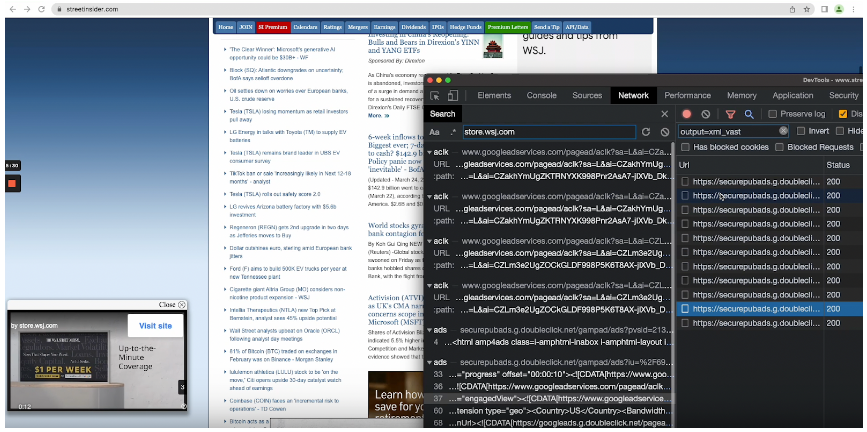
Screen recording of a Wall Street Journal TrueView skippable in-stream ad being shown twenty times to the same consumer in eight minutes, in a muted, auto-playing, out-stream video player.
On some GVP sites, the same TrueView ad is served over and over even when the consumer clicks ‘Skip’ repeatedly
On some GVP publishers, a consumer can repeatedly try to click the “Skip” button on a video ad, only for the exact same TrueView ad to be served over and over and over.
For example, in the video recording below, a consumer clicks the “skip” button as fast they are allowed to, and yet, the exact same TrueView ad for Fiverr is served back to back, with no organic media content show to them in the (out-stream, muted, auto-playing) video player.
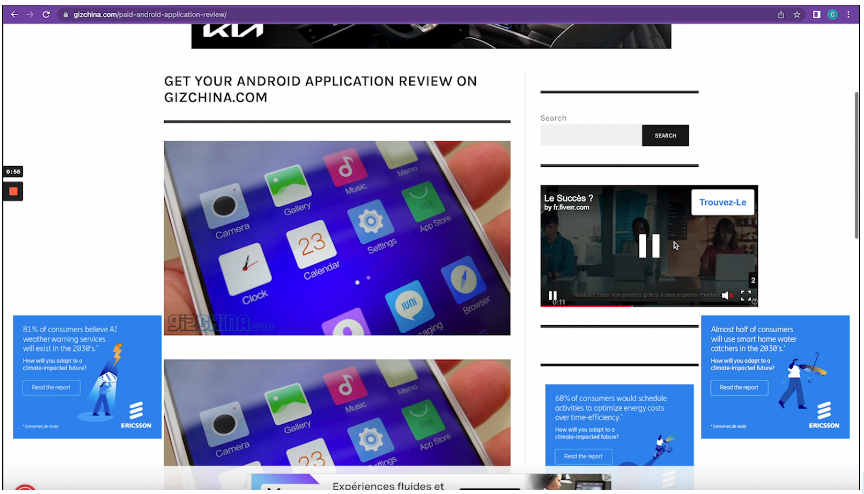
Screen recording of multiple consecutive Fiverr TrueView skippable in-stream ads being served, despite the consumer repeatedly clicking the “Skip” button.
On some GVP sites, the same TrueView ad is being served in multiple video ad players at the same time Google’s public documentation states that “No more than one video ad placement may play in view at any given time.”
However, despite this policy, on some GVP publishers, multiple TrueView ads were observed being served at the exact same time in different video slots. In some cases, it was the same brands’ ads being rendered in secondary video players.
For example, in the video recording below, one can observe multiple TrueView ads being served for Grammarly and Virgin Voyages cruise lines simultaneously. Both pairs of TrueView ads are being served in muted, auto-playing video players.

Screen recording of two YouTube TrueView ads for Grammarly and Virgin Voyages cruise lines running side by side at the same time.
For example, in the video recording below, one can observe multiple TrueView skippable in-stream ads being served for Grammarly and Virgin Voyages cruise lines simultaneously. Both pairs of TrueView ads are being served in muted, auto-playing video players.
As another example, in the video recording below, multiple Allbirds TrueView ads are being served side-by-side in different muted, auto-playing, out-stream video players.
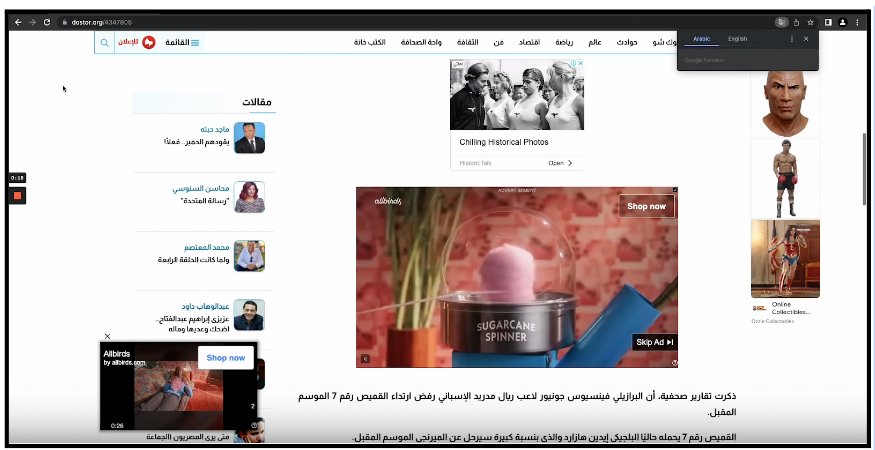
Video recording of multiple Allbirds TrueView skippable in-stream ads being served on different video players in the same time
In the screenshot below, one can observe two muted, auto-playing video players running and serving the same TrueView ad for expedia.com on “etypen-com.ngontinh24.com”.
Some TrueView ads are served on potentially copyright infringing or piracy publishers
“Google regularly receives requests to delist content from Search results that may infringe on copyright.” The Google Transparency Report” provides data on such requests to delist links from Search.”
According to Google’s online documentation,
“It is our policy to respond to clear and specific notices of alleged copyright infringement. The form of notice we specify in our web form is consistent with the Digital Millennium Copyright Act (DMCA) and provides a simple and efficient mechanism for copyright owners from countries/regions around the world. To initiate the process to delist content from Search results, a copyright owner who believes a URL points to infringing content sends us a takedown notice for that allegedly infringing material. When we receive a valid takedown notice, our teams carefully review it for completeness and check for other problems. If the notice is complete and we find no other issues, we delist the URL from Search results.”
The significance of the above documentation is that it shows Google has “teams carefully review” copyright infringement allegations, and publicizes which websites or domains have had a page that was removed from Google Search results because Google’s teams considered the given page to be infringing on a rightful owner’s copyright owner rights.
For example, one can observe that the Google Transparency Report has records of Google receiving over 15,000 individual DMCA takedown requests for delisting from search for the website “freewebnovel.com”. These 15,000 requests covered 63,002 different URLs on freewebnovel.com. In the screenshot below, one can note that of the 63,002 URLs requested to be removed on copyright violations grounds, 55,973 (88%) were reviewed by Google’s teams and then removed.
Screenshot of Google Transparency Report for “freewebnovel.com”, showing that Google’s team delisted 55,973 URLs from that website pursuant to copyright violation requests. A separate part of Google’s documentation states that “Google ads may not be displayed on websites with content protected by copyright law.”
Source: Google
However, during the course of this research study, it was observed that Fortune 500 brand’s TrueView skippable in-stream ads served on websites which had tens of thousands or hundreds of thousands of DMCA copyright violation delistings recorded in Google Transparency Report.
For example, TrueView ads purchased by Interpublic Group’s trading desk Matterkind on behalf of the brand Johnson & Johnson were delivered on the website “1stkissmanga.io”. In the lower left hand corner of the URLScan.io bot screenshot below, one can observe a partially obscured Johnson & Johnson ad being served in a muted, auto-playing video player on “1stkissmanga.io” on December 11th, 2022.
Screenshot of a Johnson & Johnson TrueView skippable in-stream ad purchased by IPG Matterkind running in a muted, out-stream, auto-playing video player on 1stkissmanga.io, a website that has had over 101,000 DMCA copyright takedowns according to Google Transparency Report
Cross-referencing the name of the website where this Johnson & Johnson TrueView ad served with the Google Transparency Report shows that “1stkissmanga.io” has had over 101,000 URLs removed from Google Search results after Google’s teams reviewed and agreed with as many copyright violation requests.
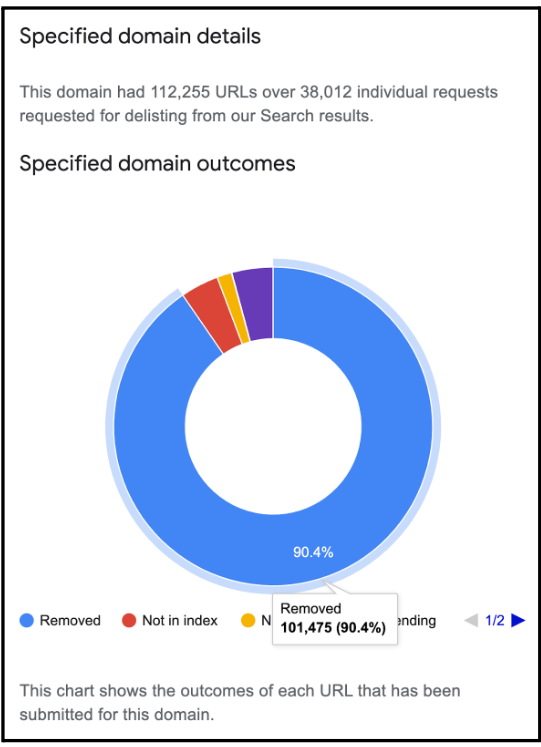
Screenshot of Google Transparency Report for “1stkissmanga.io”, showing that Google’s team delisted 101,475 URLs from that website pursuant to copyright violation requests.
In the course of this analysis, data obtained from the Google Transparency report was filtered for domains based on two criteria:
Websites that had at least 100 URLs delisted by Google in response to a DMCA copyright infringement request
Websites for which more than 70% of requests resulted in Google siding with the entity filing the infringement claim (as opposed to siding with the publisher). So for example, if a particular domain had 200 DMCA requests filed against it, and Google agreed with the complainants 100 times but did not take action the other 100 times, such a domain was excluded from this analysis (50% is below the 70% threshold).
This analysis of the Google Transparency Report identified 212,659 distinct domains which had over 100 URLs removed pursuant to DMCA copyright claims and for which more than 70% of the claims filed resulted in a removal.
Of those 212,659 identified domains, 462 of the sites appeared in various TrueView skippable in-stream placement reports. For example, four different TrueView placement reports included TrueView ad delivery against the domain “freewebnovel.com”. Freewebnovel.com has had 49,936 different URLs removed by Google’s review team in response to DMCA copyright claims, and 88% of the claims filed against this website were acted upon by Google’s reviewers.
When analyzing the subset of each TrueView ad buy that went to GVP websites, some campaigns had as much as 5.6% of their GVP webpage budget delivered against publishers with numerous DMCA copyright takedowns.
As mentioned earlier, Google received TAG’s Brand Safety Certification, which requires that any participating company acting as a seller or intermediary must:
disclose “staff and/or tools/technology used to review or flag content disclosing from media properties associated with piracy.”
“A participating company acting as a direct buyer, intermediary, vendor or seller should employ a TAG-recognised content taxonomy for harmful content” and “Digital advertisements may not be displayed in association with any content categories” such as “Online Piracy”, “Sensitive Social Issues”, “Death Injury or Military Conflict”.
It is unclear whether serving TrueView ads on websites with tens of thousands of DMCA copyright violations is consistent with Google’s TAG Brand Safety Certification. TrueView in-stream ads serving on sites that have been labeled as having high bias or low factual accuracy In October 2022, ProPublica published an article titled: “How Google’s Ad Business Funds Disinformation Around the World”, which alleged “Google is funneling revenue to some of the web’s most prolific purveyors of false” The ProPublica report mentioned that Google “has publicly committed to fighting disinformation around the world, but a ProPublica analysis [...] documented how Google’s sprawling automated digital ad operation placed ads from major brands on global websites that spread false claims.”
As previously discussed, a CNN investigation previously found that YouTube “Ads from the Washington Post and New York Times appeared on far-right and conspiracy channels like Black Pigeon Speaks and some run by InfoWars.” CNN reported:
YouTube “advertisements potentially funded by US tax dollars also appeared on the channels promoting North Korean propaganda.” "It appears that YouTube did not follow its own protocols and categorize these videos properly," the New York Times told CNN. The paper said its ads should only appear on a list of pre-approved sites. If the channels are monetized -- which InfoWars has previously claimed they are -- the major newspapers could have unknowingly supported disinformation and conspiracy.” The study of disinformation and mis-information is a developing field of social science, with no universally agreed upon methodologies. Therefore, any attempts to classify the factual accuracy or biases of a given website is likely to attract reasonable critiques and counter-arguments. Brands, media buyers, researchers, or individual consumers must adjudicate for themselves what are reasonable assumptions and methodologies when rating various publishers as sources of disinformation.
As a very superficial and exploratory analysis, this study drew upon the Media Bias/Fact Check (MBFC), a resource which rates sites in two areas: bias and factual accuracy. The Media Bias/Fact check has been used by researchers at the University of Michigan to create a tool called the "Iffy Quotient", which draws data from Media Bias/Fact Check and NewsWhip to track the prevalence of "fake news" and questionable sources on social media. The MBFC has attracted criticism about its robustness and methodologies from a number of sources, including the Columbia Journalism Review, Poynter Institute, media pundits, and other researchers.
A study published in Scientific Reports wrote: "While [Media Bias/Fact Check's] credibility is sometimes questioned, it has been regarded as accurate enough to be used as ground-truth for e.g. media bias classifiers, fake news studies, and automatic fact-checking systems." As part of a very superficial analysis, this study curated a list of websites and domains, for which MBFC rated the given domain as having ‘low’ or ‘very low’ levels of factual accuracy. This list of domains was then compared against the lists of websites and domains where brands’ TrueView skippable in-stream ads were served. Approximately 1.7% of brands’ TrueView GVP Website budget went to websites which had a ‘low’ or ‘very low’ factual reporting rating from MBFC. For example, one brand had their TrueView skippable in-stream ads previously served on RT.com (Russia Today), which is currently under European Union sanctions over alleged disinformation after the Russian invasion of Ukraine. Media Bias Fact Check rates the Russian News Agency TASS as having “Low Credibility”, due to “Propaganda” and “Poor Sourcing”. One can observe that the media agency Essence (part of WPP) purchased YouTube TrueView ads on behalf of the athletic equipment vendor Peloton on Tass.ru in November 2021. The ads played below the view-port in a muted, auto-playing video player. As mentioned earlier, the study of disinformation is an evolving social science, and brands or individuals should make their own adjudications as to what methodology they find robust when trying to evaluate various news sources. Adalytics does not necessarily concur with or support the methodology proposed by MBFC; this analysis merely serves as a superficial exploratory demonstration for how one could choose to evaluate how much TrueView in-stream ad budget was spent on disinformation publishers in the Google Video Partner network. TrueView in-stream ads serving on content discussing “sensitive current events like war, death, or tragedy” As mentioned in the Background section of this report, Googles’ Video Ad Safety Promise states that “certain types of content can’t be monetized for ads on YouTube and Google video partners: we'll automatically apply exclusions to prevent your ads from showing on the most controversial content, such as terrorist acts, nudity, and recent sensitive events.” Google’s online documentation states that “Your ads automatically will be excluded from showing on the following types of content, no matter what inventory type you choose.”, and this list includes “Content discussing terrorism or sensitive current events like war, death, or tragedy”. However, despite Video Ad Safety Promise, multiple instances of TrueView ads were observed serving on content discussing sensitive current events like war, death, or tragedy. For example, in the screenshot below, one can observe TrueView ads serving in a muted, auto-playing video player for “planyournovascotia.com”. The ads are served on an Arabic news website page - “https://www.lebanonfiles.com/articles/%d8%a3%d8%ae%d8%a8%d8%a7%d8%b1-%d8%a7%d9%84%d8%b3%d8%a7%d8%b9%d8%a9/%d8%b4%d8%b1%d8%b7%d8%a9-%d9%88%d9%84%d8%a7%d9%8a%d8%a9-%d9%86%d9%87%d8%b1-%d8%a7%d9%84%d9%86%d9%8a%d9%84-%d8%a5%d8%ae%d9%85%d8%a7%d8%af-%d8%aa%d9%85%d8%b1%d8%af-%d9%81%d9%8a-%d8%b3%d8%ac%d9%86/”. The title of the page translates to: “River Nile State Police: Putting down a revolt in "Al-Damer" prison, after the events led to the death of a policeman and the wounding of 7 prisoners”.
Screenshot of a TrueView skippable in-stream ad serving on an article about: “River Nile State Police: Putting down a revolt in "Al-Damer" prison, after the events led to the death of a policeman and the wounding of 7 prisoners”
In another instance, TrueView in-stream ads for Fiverr and for Canadian fintech Moneris were observed running at the same time, in muted, out-stream video players on “https://www.dostor.org/4381386”, where in the article was discussing (in Arabic) - “The arrest of a fugitive who is required to be executed in provisions amounting to 252 years in Alexandria”.

Screenshot of two TrueView in-stream ads serving simultaneously in muted, auto-playing, out-stream video slots on an article discussing the criminal penalties and execution
In a third example, TrueView in-stream ads for the online game Eve Online and for Murphy Wall Beds were observed serving in a muted outstream video player on newsmax.com. The title of the particular Newsmax article was - “9 Dead, Including Shooter in Allen, Texas, Mall Massacre”.
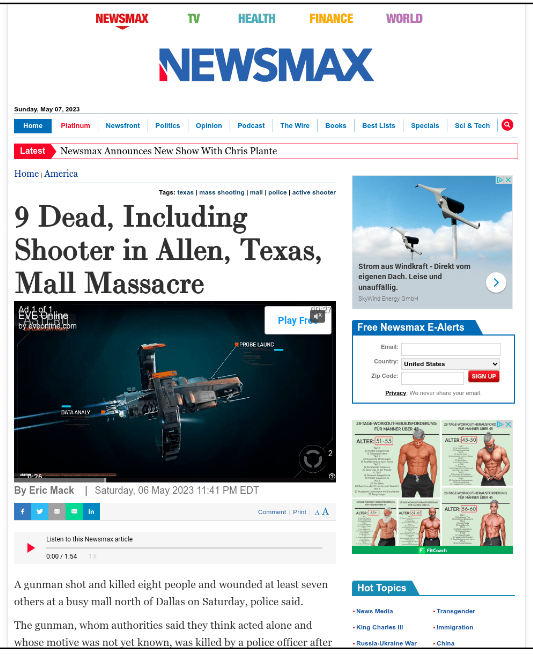
The particular video in question on Newsmax makes public references to childrens’ deaths. It is unclear whether the placement of TrueView skippable in-stream ads on this particular Newsmax article are consistent with Google’s Video Ad Safety Promise, or the Media Ratings Council’s YouTube accreditation for brand safety. As mentioned earlier, Google received TAG’s Brand Safety Certification, which requires that any participating company acting as a seller or intermediary must:
“A participating company acting as a direct buyer, intermediary, vendor or seller should employ a TAG-recognised content taxonomy for harmful content” and “Digital advertisements may not be displayed in association with any content categories” such as “Online Piracy”, “Sensitive Social Issues”, “Death Injury or Military Conflict”.
It is unclear whether serving TrueView in-stream ads on articles about executions or children being murdered is consistent with Google’s Brand Safety Certification.
TrueView in-stream ads serving on “made-for-advertising” websites
Many TrueView in-stream ads were observed delivering on so-called “Made for Advertising” (MFA) sites.
Publisher quality intelligence vendor DeepSee.io describes MFA sites as publishers who meet the intersection of 3 factors:
Highly paid inbound traffic audience mix (e.g., the majority of site visitors come to the site by first clicking on an ad, rather than through direct browsing, clicking on a backlink from another site, or through search engine results)
Excessively high density & frequency of advertisements (for example: showing 10+ ads at the same time, and refreshing the ad slots every few seconds)
Click bait content, often syndicated across an entire family of MFA sites
Many TrueView ads were on Google Video Partner publishers which are on DeepSee.io’s MFA list. For example, in the screenshot below, one can observe a hotels.com TrueView skippable in-stream ad serving in a muted, auto-playing out-stream video player on a site where a significant proportion of the screen is covered in ads, the ads auto-refresh, and a significant percentage of the site’s audience get to site by clicking on Facebook or Taboola ads.
In another example, one can observe a muted, auto-playing TrueView ad for the car brand Mazda serving on “gameofglam.com”, adjacent to large numbers of other ads that auto-refresh.
In another example, one can observe an American Express TrueView ad purchased by IPG Matterkind serving in a muted, out-stream, auto-playing video player on “historictalk.com”, another Made for Advertising site according to DeepSee.io.
TrueView ads for Hyundai (purchased by the media agency Canvas) were also observed serving in muted, auto-playing, out-stream video players on “historictalk.com”.
Using DeepSee.io’s industry leading list of Made for Advertising domains, it was calculated that 12.3% of the budget spent on Google Video Partner (GVP) sites is spent on MFA publishers. There were 1090 distinct MFA publishers from DeepSee.io’s list that appeared in various brands’ TrueView campaign reports.
Analyzing Google Video Partner (GVP) mobile apps
In addition to carefully analyzing the 3rd party websites that appear in brands’ TrueView in-stream placement reports, this study sought to evaluate the Google Video Partner mobile applications where TrueView ads were being delivered.
For one of the Fortune 500 brands analyzed in this study, more than than 50% of their TrueView in-stream campaign budget was delivered against GVP mobile applications.
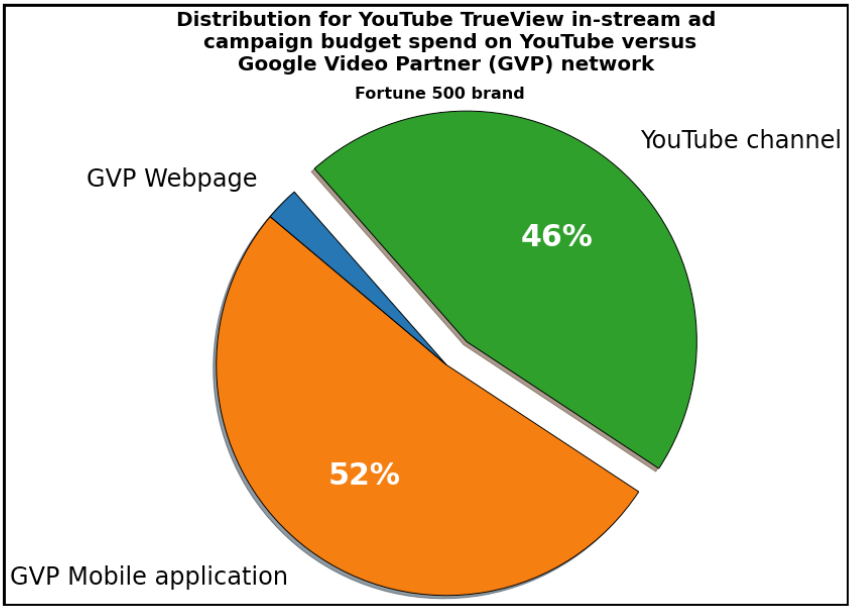
There were over 25,000 unique mobile applications against which TrueView ads were reported as delivering against. This included:
Google Play Store Android mobile apps
Apple App Store iOS mobile apps
Amazon Appstore apps
Apps that have been removed or delisted from the app stores
Apps that are unlocatable in the Android, iOS, or Amazon app stores
Apps that appear to be “sideloaded”
According to Wikipedia, “When referring to Android apps, "sideloading" typically means installing an application package in APK format onto an Android device. Such packages are usually downloaded from websites other than the official app store Google Play. For Android users, sideloading of apps is only possible if the user has allowed "Unknown Sources" in their Security Settings.”
Google ad exchange seller IDs that appear in placement reports in lieu of an app name or bundle, which makes it impossible to know exactly against which app ads were delivered against
Over 80% of the TrueView spend going to mobile apps is allocated to gaming apps
To analyze the mobile apps against which video ads were being delivered in brands’ TrueView in-stream placement reports, first all app placements were categorized as one of the following, based on their app name and/or app bundle:
Android apps (50% of GVP mobile app budget)
iOS apps (41% of GVP mobile app spend)
Amazon apps (5% of GVP mobile app budget)
Unlocatable, side loaded, or de-listed apps (4% of GVP mobile app spend)
Ad Exchange seller ID in app name rather than actual name of mobile app where ad served (~0.4% of mobile app spend)
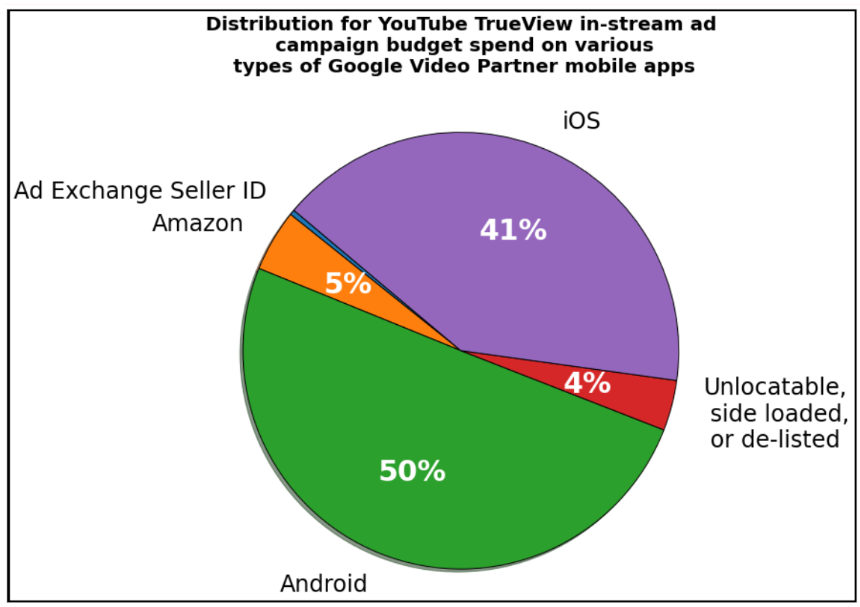
Secondly, the apps from the Android or iOS app stores where TrueView ads were served were analyzed by app type. For example, one can manually check the Google Play Store and see how a given app is characterized. For the app “Happy Color®: Coloring Book” Android app is labeled as a “Game” - https://play.google.com/store/apps/details?id=com.pixel.art.coloring.color.number&hl=en&gl=US
The top Android apps across the different brands’ TrueView placement reports by ad budget spent were primarily games. The top five apps by collective TrueView spend were:
Happy Color®: Coloring Book
Candy Crush Saga
Words With Friends Crosswords
Crossword Jam
TPlayer - All Format Video
When analyzing all the brands’ TrueView reports, it appears that - of the TrueView ad budget that was delivered against Android mobile apps - 86.8% of spend was allocated to Gaming apps. 2.1% of spend was allocated “Tools” apps, such as “Bravo Cleaner”, an “ an Android application for junk file removing” or “CC FileManager”, a file manager, or “Normal VPN - Stable&Safe Proxy”, an app with 50+ million downloads whose developer contact email address is a Protonmail email, Privacy Policy doesn’t list any official corporate address, and whose corporate landing page miss-spells “Terms of Use” as “Term of user”.
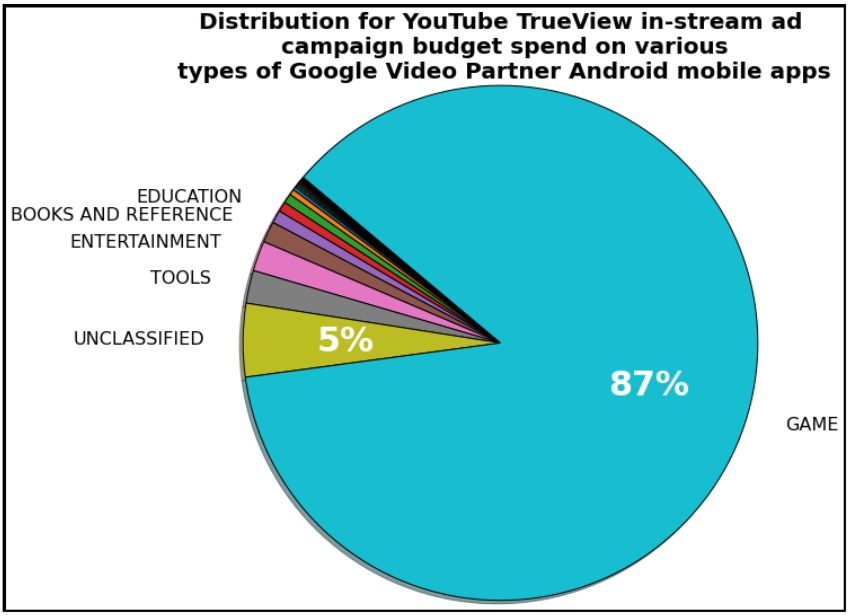
Similarly, the proportion of TrueView ad budget allocated to Apple iOS mobile apps is dominated primarily by mobile gaming apps. Of the sub-set of YouTube TrueView ad spend allocated to Apple iOS GVP mobile apps, 82% was spent on various gaming apps. Besides unclassified apps, the second largest category by spend was Education related apps. The top five iOS apps, by percent of spend, were:
As discussed in the “Background” section of this report, Google’s public online documentation states that “games” are a type of "non-in-stream video placements”, which would likely make them in-consistent with the requirements for TrueView in-stream video ads.
Furthermore, a separate section of Google’s public online documentation states that “Out-stream video ad formats include: [...] Interstitial ad units - rich, full-page ads in your app. Place them at natural breaks and transitions in your app's interface, such as at launch, after level completion in a gaming app, or after an article view in a news app. These ads are supported for mobile app inventory” (emphasis added).
Majority of ad spend on GVP mobile apps is going to non-US-based publishers
For the proportion of TrueView ad spend going to GVP Android mobile apps, one can analyze which of those Android apps are registered to developers based in foreign countries. The Google Play Store lists a public “developer address" for many Android mobile apps, which can sometimes (but not always) be used to deduce where the publisher of a given Android app is based.
Screenshot of Google Play Store for Candy Crush Saga, showing the app developer is based in Malta.
Of the sub-set of TrueView ad budget that was allocated against Google Video Partner Android mobile apps, 22.3% was spent on Android apps whose developer is registered in the United States. 14.3% was spent on apps developed by entities registered in China, and 9.6% was spent on apps whose developer is registered in Cyprus.
United States of America - 22.26%
Unknown - 14.84%
China - 14.34%
Singapore - 10.31%
Cyprus - 9.61%
Malta - 6.36%
Germany - 2.44%
Turkey - 2.33%
United Kingdom - 2.15%
Israel - 1.95%
Denmark - 0.64%
Russia - 0.08%
For example, one brand had several hundred dollars worth of TrueView ad spend delivered against the Word Game “Word Crush - Fun Puzzle Game”, whose developer “TangramGames” is registered in Beijing.
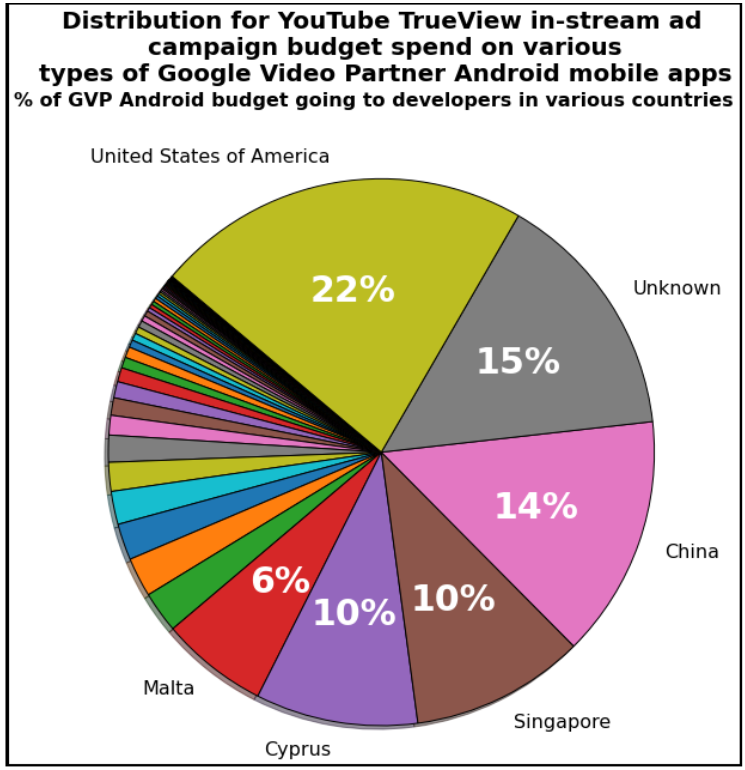
TrueView ads served on side-loaded apps
Of particular interest was the observation that approximately 4% of brands’ TrueView in-stream ad budget was delivered against mobile apps that appeared to be un-locatable or delisted from the Google Play Stores.
For example, several brand appeared to have TrueView in-stream ad delivery in their placement reports against the Android mobile app “ Double Cleaner” (app bundle id “com.doublecleaner.dailyuse”), whose app store URL was: “https://play.google.com/store/apps/details?id=com.doublecleaner.dailyuse”. However, visiting said app store URL shows the app is no longer publicly listed.

Screenshot of the Google Play listing for the “Double Cleaner” Android mobile app
Generally speaking, it can be hard to differentiate between apps that were delisted versus apps that are sideloaded. Sideloading refers to “installing an application package in APK format onto an Android device. Such packages are usually downloaded from websites other than the official app store Google Play. For Android users, sideloading of apps is only possible if the user has allowed "Unknown Sources" in their Security Settings.”
However, some apps appear to have never been listed on the Google Play Store in the first place, or were not listed in the recent past. Furthermore, for these apps, there are multiple sources offering consumers the option of downloading those apps via sideloading a raw .apk file.
For example, some brands had significant TrueView in-stream delivery against the mobile app bundle “ir.topcoders.nstax” - the “Insta X (Free Advanced Instagram)” mobile app. This app bundle does not appear on the Google Play Store, however, multiple sources in search engine results offer to allow consumers to download the raw .apk file to sideload these apps onto their Android devices.
TrueView ads served on publishers that are potentially under US Treasury sanctions
The U.S. federal government maintains “what are known as “comprehensive sanctions” that have the effect of prohibiting U.S. persons from participating in most transactions, collaborations and activities with certain countries. With few exceptions, the U.S. will bar most transactions, collaborations or activities involving a comprehensively sanctioned country or individuals and entities from those countries.”
Iran is one country which is under “comprehensive sanctions”. The United States Department of Treasury, Office of Foreign Assets Control (OFAC), “has the primary authority to regulate sanctions under the Iranian Transactions and Sanctions Regulations (ITSR) under 31 CFR Part 560.” The “ITSR will generally require authorization from OFAC for any U.S. person who wishes to conduct any transaction or engage in any activity with the country of Iran, or specially sanctioned individuals or entities under the ITSR.” Some *TrueView placement reports had significant volumes of budget allocated to apps such as “ir.topcoders.nstax” - “Insta X (Free Advanced Instagram)”. This app is described as “The most up-to-date Free Persian Instagram.” The app was “made with specialized knowledge and reverse engineering”.
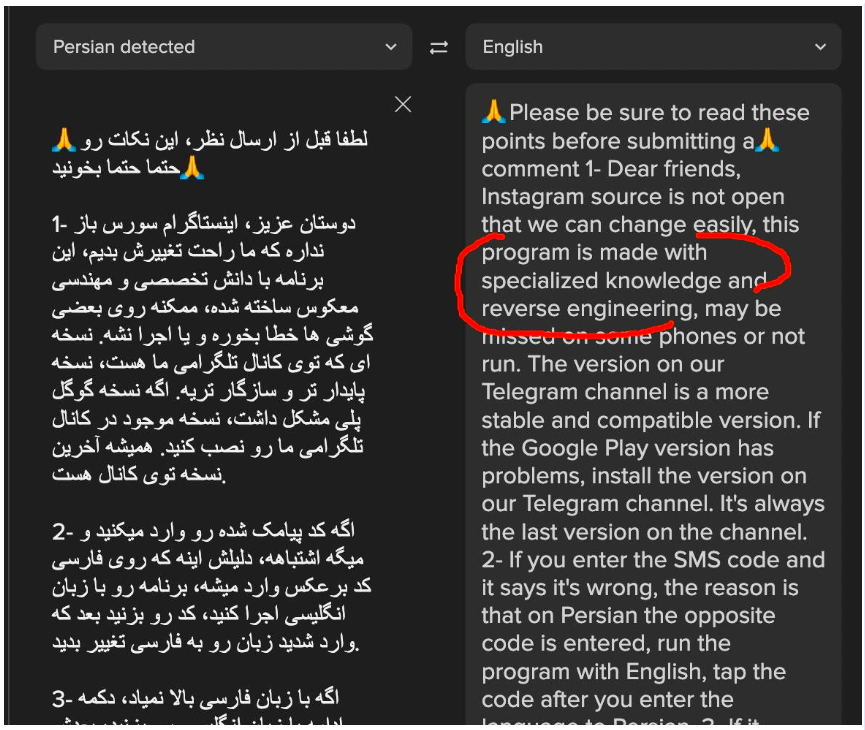
The developer behind "Insta X (Free Advanced Instagram)" or `ir.topcoders.nstax` is Ramin Eftekhari, an Iranian software engineer based in Tehran, Iran. He completed his Master of Sciences degree in computer software engineering at Raja University of Qazvin. His thesis was the static analysis of android apps for finding malware.
As mentioned earlier, Google received TAG’s Brand Safety Certification, which requires that any participating company acting as a seller or intermediary must:
“must employ pirate mobile app filtering for all advertising displayed in a mobile app environment.”
It is unclear whether serving TrueView in-stream ads on an Iranian app that uses “reverse engineering” to extract content off of Instagram in accordance with Google’s TAG Brand Safety Certification or Google’s Video Ad Safety Promise.
Another mobile app that appeared in brands’ TrueView placement report was “info.sunista.app”. “Sunista is a modded Persian version of Instagram Messenger”, and also described as “Sunista is a modded version of the popular social media app Instagram for Android, developed by an Iranian team.”

Screenshot of the landing page for the Sunista mobile app
On Tuesday April 4th, 2023, a user posted a thread on Reddit titled: “Refusal by Google to remove fraudulent Apps from Display targeting.” The thread mentions that the media buyer had large amounts of allegedly fraudulent ad impressions delivered against the “ir.topcoders.nstax” and “info.sunista.app”. The media buyer claimed:
“For a few days, we have an app, that is drawing ridiculous amounts of impressions compared to our other URLs. We're talking 10's of thousands of impressions when other URLs and apps have maybe 100. These are called: mobileapp::2-info.sunista.app and mobileapp::2-ir.topcoders.nstax When we try to exclude these from the campaign, we get an error message saying they could not be removed from the campaign. So we got in contact with Google Support, who said they'd remove it, just to then be stumped when they also could not remove these links from our targeting. A few hours later they explained: "This email is in regards to the query which you have raised about excluding the placements in your Google Ads account XXXXXXXXX. As discussed, we have escalated the query to the concerned team and found that there is no issue at our end. 1)Maybe the URL that you are trying to exclude doesn't exist as mentioned in the error message, please try to exclude it by app ID if you have one. 2)Or the app might have been removed or changed its name/id or maybe it's not even connected to the google network. That is the reason we were able to remove the other placements but not these." They cannot be serious, can they? If the apps are not connected to them or not exist, then why are they still showing thousands of impressions on those platforms today? These seem like clear click fraud apps. Did anyone have a similar issue? Or anyone have an idea how to solve this? I'm thinking of just going whitelist, which will massively reduce the reach of the campaign, but at this point seems to be the only way to move forward…”
If this anonymous Reddit post is accurate - it is unclear whether it is consistent with Google’s TAG Brand Safety Certification. TrueView ads served on mobile apps which do not properly disclose they contain ads Google’s online public documentation states that Android app developers must inform prospective app users whether or not a given mobile app contains advertising. Consumers can see these labels on the Google Play store. For example, in the screenshot of the Google Play Store listing for the Duolingo mobile app below, one can see the “Contain ads” label underneath the name of the app.
Screenshot of the Google Play Store listing for the Duolingo mobile app, showing the “Contains ads” label
Google’s public online documentation states that app developers “must declare whether or not your app contains ads,” and that: “Apps that contain ads will have a "Contains ads" label shown on their store listing. This label will be visible to all Play Store users.”
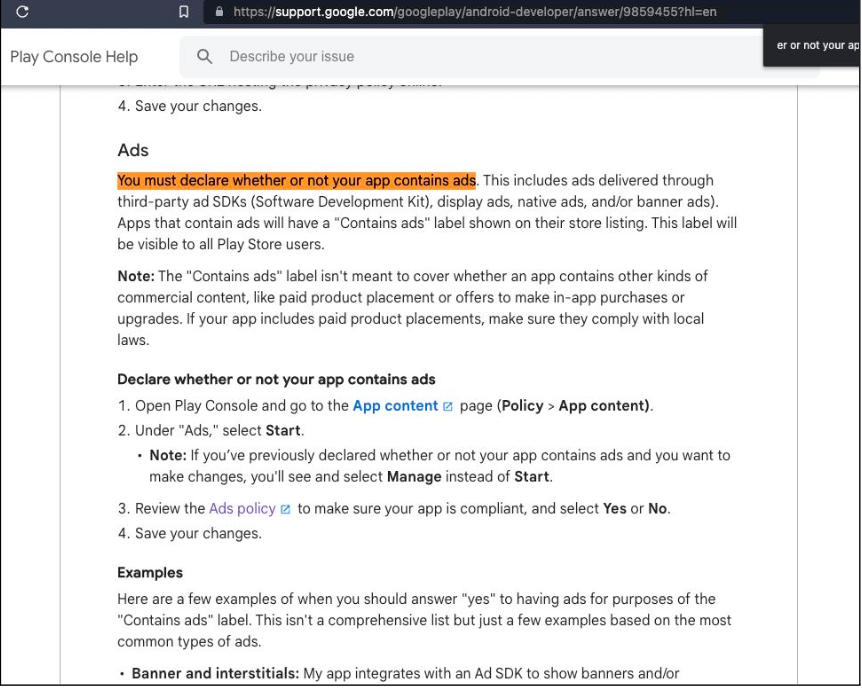
Source: Google
Furthermore, Google’s online public documentation states that while Android app developers are “responsible for accurately declaring ad presence in your apps, Google may verify this at any time and display the "Contains ads" label if appropriate.” The documentation also states that “If you misrepresent the presence of ads in your app(s), it's considered a violation of the Google Play policies and may result in your app(s) being suspended.”

Source: Google
In previous testimony, representatives from Google told lawmakers in Congress that the fees the Google Play Store charges app developers are meant to cover the costs that go into distributing apps through their platforms and securing them appropriately.
However, despite Google’s written policies requiring that Android app developers transparently disclose whether a given app contains digital advertising, this research study found 202 Android apps appearing in brands’ TrueView in-stream ad campaign reports, wherein the Android apps do not disclose that the apps contain ads. For example, the Android mobile app “Match 3D Master Matching Games'' appears in TrueView ad campaign placement reports as a Google Video Partner. However, the Google Play Store listing for this particular app is noticeably missing the “Contain ads” designator. In addition to the fact that this Android app appears in multiple ad campaign reports, it also contains numerous user reviews which complain about the large amounts of ads serving in these apps.
Screenshot of the Google Play Store listing for the Match 3D Master Matching mobile app, showing the “Contains ads” label is noticeably absent, despite the fact that TrueView ads were served on this Android app.
Other examples of Google Play Store apps which appear in TrueView advertisers’ placement reports, but do not follow Google’s policies requiring they disclose the “Contains ads” label, include:
In total, this study found TrueView ads delivered on 202 different Android apps, for whom the Google Play Store listing does not accurately include the “Contains ads” label. As mentioned earlier, Google’s public online documentation states that “Google video partners are high-quality publisher websites and mobile apps where you can show your video ads to viewers beyond YouTube” (emphasis added). “Video partner publishers are carefully vetted and must meet Google's inventory quality standards.’ It is not clear whether Google's careful vetting of its video partners includes validating whether or not those video partners are complying with Google’s written policies on disclosing the presence of apps in games. Google’s documentation states that “If you misrepresent the presence of ads in your app(s), it's considered a violation of the Google Play policies and may result in your app(s) being suspended.” TrueView ads served on mobile apps meant for young children & toddlers
During the course of this study, it was observed that advertisers’ TrueView skippable in-stream ads were being served on mobile apps intended for young children.
For example, some brands had their ads served on the Android “Educational Puzzles for Kids” mobile app. Based on consumer reviews, this app is generally used by children as young as two years old.
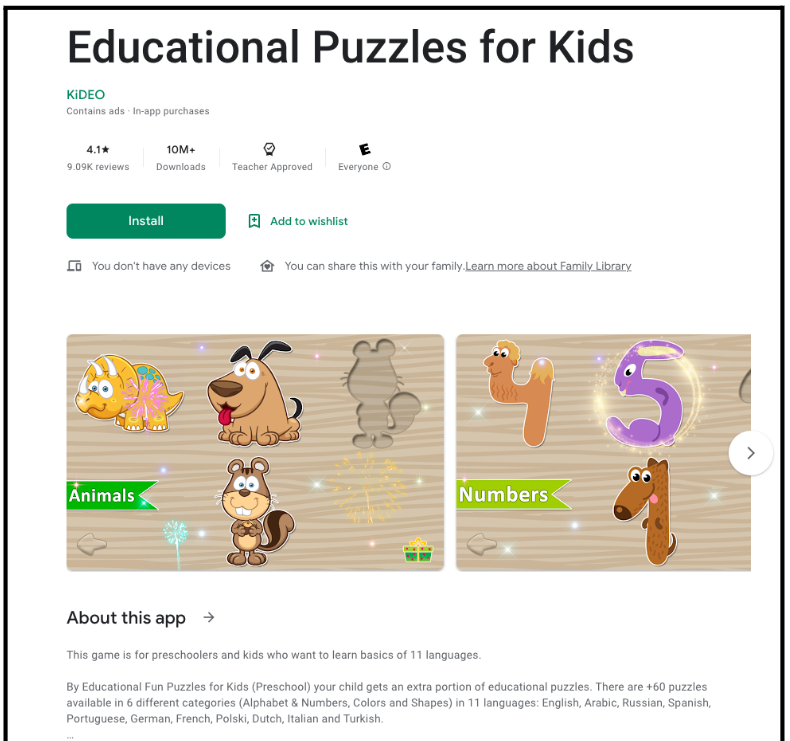
Numerous parents expressed concerns about the ad serving experience in this app:
“The ads are ridiculously intrusive. My 2 year old can hardly complete a puzzle because the ads are so large and easy for little fingers to accidentally click on. The she gets stuck in accidentally loop of trying to exit the app to get back to her game. They should just have the ads at the beginning for the adults to deal with and have a clear screen for the kids to play on. Would rate 0 if I could."
"I love this game for my 2 year old. My only complaint are the ads that come up that my child clicks on. Which are not appropriate for a 2 year old. Realty and homes. So she ends up clicking them. This app should instead emplay ads that advertise other games or take them to app store. Because of these ads I'm deleting this wonderful app that otherwise would be great."
"Ads?! My 18 month old cannot read and I sure as heck am not purchasing a game that would try to get click bate from toddlers accidentally clicking. Game would be great if it weren't for the ads.... uninstalling this and I would recommend not installing until they fix this issue"
Another group of advertisers - including Fortune 500 brands - had their TrueView in-stream ads delivered on the “Cars for kids - Car builder” Android app.
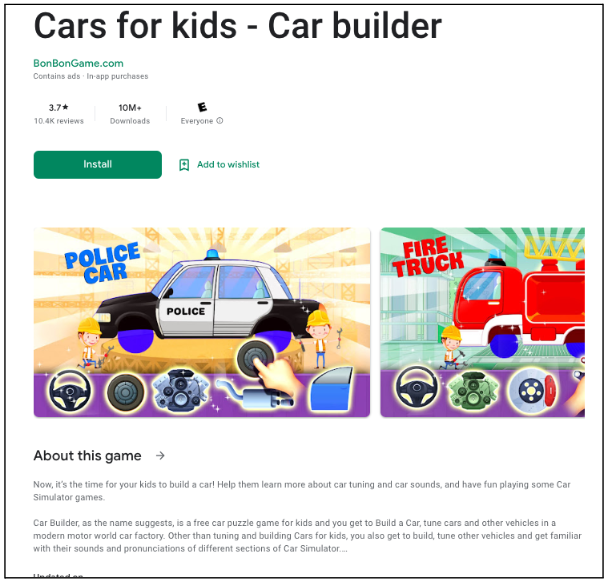
Numerous parents expressed concerns about the ad serving experience in the “Cars for kids - Car builder” mobile app:
“Please add a way to pay to remove ads. The state of the app right now needs a constant guidance from parent, because the ads are appear almost on every play, and the ads change very often hence very hard for kids to locate the close button, thus defeat the purpose of an app for kids. It made kids stress more than learn.”
“Would be 5 stars but there are too many ads and no way to remove them. My kiddo absolutely loves the activities but they only last mere seconds before the ads start. And they aren't even ads geared towards kids and require reading to close out of them. It's absolutely ridiculous that in the review section you have been claiming to be fixing it for 2 years. I would gladly pay for an ad free version but until it exists I'll be uninstalling.”
It is not clear whether Google’s “careful vetting” of high quality Google Video Partners includes checking how the ad serving experience affects young children. It is also unclear whether Fortune 500 brands or advertisers expect their TrueView in-stream ads to serve on mobile apps targeted towards 2 year olds. In 2020, the Wall Street Journal (WSJ) reported that “Google wants to substantially limit the information a key auditor of YouTube can share about the risks of advertising on the video service”. WSJ wrote that an auditor “is refusing to sign a contract that would prevent it from reporting to clients when ads have run in videos with sensitive subject matter, including [...] children's content.”
One media agency executive, who was shown an advanced copy of some of these research results, said:
“TrueView ads should not be present in any apps meant for kids. It represents an unnecessary risk for advertisers, particularly since those advertisers have little control over the placement of their ads. It is particularly concerning when ads meant for mature audiences, such as alcohol ads, are included in such apps.”
Thousands of TrueView ads were served to bots
As mentioned before, YouTube does not allow independent 3rd party verification pixels in its ad campaigns. YouTube also does not provide impression level log file data to media buyers, unlike other advertising platforms such as the Trade Desk or MediaMath DSP.
During the course of this study, it was observed that thousands of TrueView in-stream ads had been served to the openly declared bot run by HTTP Archive. The HTTP Archive bot runs out of a Google Cloud data center server.
It is not clear why Google’s systems were serving ads to a declared bot running out of a Google Cloud data center, or what percentage of brands’ total TrueView ad budget was served to bots.
Source: HTTP Archive
Ads from numerous Fortune 500 and government advertisers may have served on invalid TrueView skippable in-stream environments
The list of affected brands observed throughout the course of study, whose TrueView skippable in-stream ads may have served on in-eligible muted, auto-playing, out-stream video slots, includes many Fortune 500 brands, the European Parliament, US federal, state, and municipal government entities, numerous non-profits like the Environmental Defense Fund (EDF), and political advertising campaigns for entities such as Senator Mike Lee of Utah (the sponsor of the AMERICA Act).
This list includes:
#1 Mittel hilft
#cleanffm
AIDA Cruises
AMCI : Advanced Micro Controls Inc.
ANWB Communicatie
AXA Deutschland
Accent Clothing
Adbaker
Adler Pharma
Adobe Creative Cloud
Adobe DE
Adobe Document Cloud
Adobe Document Cloud JP
Adobe UK
AdobeCreativeStation
AdriaCamps.com
Aeroméxico
Aflac
Air Caraïbes
Airbnb
Aktion Deutschland Hilft
Al Mustafa Welfare Trust
Alba Moda
Albert
AllDentZahnzentrum
Allbirds
Alles Gold
Amaze
Amazon Music
Amazon.de
American Committee For The Weizmann Institute Of Science Inc
American Express Business
Amit Bhawani
Amundi
Ancestry Deutschland
Angel Soft
Anheuser-Busch InBev
Ankerkraut
Anxiety Specialists
Arena Stage
Argos
Arm & Hammer Laundry
Ascension Careers
Ashley
Ashyleigh
Atera
Athletic Greens
Atlantis Dubai
Atlassian
Atlassian Confluence
Audiio
AugustinusBader
Aurélien
AutoScout24
Autohaus NIX GmbH
Aveeno Canada (Johnson & Johnson owned)
Avoury. The Tea.
B&H Photo Video
BAMorg
BAUR Versand
BB Promotion GmbH
BBC Trailers
BDroppy
BMFSFJ
BMOCommunity
BTN Münzen - Deutsche Ausgabestelle
Baker Ross
BandaiUK
Bar-Bar-A Horse & Livestock Drinkers
BarDeluxe
Bartlett Tree Experts
Bayer Gesundheit
Bechtle AG
Beliani
Bellroy
Belstaff
Bereit zu Reisen DE
Best Buy
Big Scary Games
Bihl+Wiedemann GmbH
Billboard
Binance NFT
Blacklite District
Bloomberg Originals
Bluehost
Bluemotion 3D
Bob Diamond - America's Tax Sale Attorney
Booking.com
Born Primitive®
Bosch Profi-Elektrowerkzeuge und Zubehör
Bose
Brembo
Brilliant Earth
Briscoes New Zealand
Brooks Running France
BrytiagoTV
Burga
CAR-REP
CHERRISK
CIBC
CLEAN FITNESS
CLUSE
CMC Markets plc
COPA90 Football
CROWZ
Calgary Co-op
California Closets
California Science and Technology University
Calvin Klein
Cam Clark Ford TV
Canadian Energy Centre
Cannon Downriggers
Capital.com
Carbify
Casinos Austria
Casper
Charles Tyrwhitt
Chase
ChevyChaseAcura
Chickfila
Chris Anderson
Chris M. Walker
Christoph Magnussen
Christopher Walker
CiscoGermany
ClearScore
ClickCease
Cloud Sangha
Coca-Cola Deutschland
Coffee Circle
Cointreau U.S.
Coloplast Italia
Colorful Standard
Columbia Sportswear
Comarch Finance
Comarch Large Enterprises
Commerzbank AG
Compose AI
Consumer Cellular
Coolblue Advertising
Corendon Airlines
Costa Rican Vacations
CrowdFarming
Culligan Water
DAZN
DICK'S Sporting Goods
DIJET EUROPE
Dafi
Dance Fruits
Danley's Garages
DataCamp
Debbie Graney
Debitam
Dedoles DE
Dell
Dell Technologies APJ
Dell Technologies Deutschland
Deutsche Glasfaser
Deutsche Grammophon - DG I Stories
Deutsches Rotes Kreuz e.V.
Dialpad
Dimary
Disney Plus CE
DocMorris
Domestika
Domino Printing UK
Doors2Floors
Doptelet® (avatrombopag)
Dot STORE Domains
Down East Gear
Dr. Squatch
Dropbox Sign
Drunk Elephant Skincare
Dungeon Alchemist
Duschmeister
Dyson
EA SPORTS FIFA
EHF Home of Handball
EVE Online
EY Germany Switzerland Austria
Ecover Deutschland
Edelmetallhandel Zeltmann e.K.
Eight Sleep
Elementor
Emirates
Empower
England & Wales Cricket Board
Enterprise
EnviroKlenz
Environmental Defense Fund
Epilog Laser
Ergotopia
ErstmalzuPenny
Espadrij
Etihad Airways
Europa-Park GmbH & Co Mack KG
European Flight Academy
European Parliament
Eurowings
Exmark Manufacturing Inc.
Expedia
Expo 2020 Dubai
F-Secure
FINN
FREDERIQUE CONSTANT GENEVE
Fachhochschule Graubünden
Falcon's Resorts by Meliá
FatFace
Fever-Tree
Financial Times
Fire Follows
Firestone Tires
Fit!
Fiverr
Flanax
Flutterwave
Focus Entertainment
Ford Motor Company
FordCanada
Fortinet
Fortrade Online Trading
FreeTaxUSA
Fresco Dog Foods GmbH
Freshly Cosmetics
Fressnapf
Future Electronics
G-P
GLAMIRA
GMC Canada Offers
GOAT
GPS and TRACK LLC
GRIP6
GT's Living Foods
GUT Bebra
Game of Thrones Winter is Coming
Genesis USA
Gerdmans OY
Get Schooled
Getir
Giovanni Raspini
Glico Japan江崎グリコ 公式
Go Türkiye
GoDaddy
GoDaddy Deutschland
GoDaddy United Kingdom
GoPro
GoTo
Goodyear Deutschland
Google Ads
Google Canada
Google Career Certificates
Google Chrome
Google Small Business
Google Workspace
Gotoトラベル
Grammarly
Green Petfood
Grubhub
Gryt Health
Guardio
Guild Wars 2
Gula Tech Adventures
Gvoke®
Gymondo
HP Deutschland
HSN
Hankook Tire Global
Hardcore Closer
Health Carousel
Health Mantra
Healthful Squad
Heather Itzla
Hello Seven
HelloFresh Deutschland, Österreich & Schweiz
Hero Wars
Hero Wars Web
HertzIT
Hochschule Furtwangen
Hogan
Hollister Co.
HomeToGo Deutschland
Honda Canada Inc.
Honda Outdoors NZ
Hotels.com
Hotjar
HotwireTravel
Hyundai Deutschland
HyundaiUSA
HyundaiWorldwide
Háskólinn í Reykjavík - Reykjavik University
Hårklinikken
Hövding Sverige
IB-Freiwilligendienste
ICC
IG Deutschland
IKEA JAPAN
INNSiDE by Meliá
INTERSPORT Deutschland
IONOS Deutschland
IQAir
IkPas
Imagine Your Korea
ImmoScout24
Indeed
Inspire Uplift
Instacart
InterSystemsCorp
Interdiscount
Internorm Fenster & Türen
Interrail
Investing Outlook
Investor's Business Daily
Island Questaway Web
JDYS.W
JYSK TV spots
JalouCity
James Hardie
Jamones Ibéricos EU
Jeans Fritz
Jergens Skincare
Jimdo.de
Jobcase
John Reed Fitness Music Club
Johnnie Walker
Joyn Deutschland
Juan Cuenca Paris
Juice Technology
Juristu Incassodiensten
KAYAK
KHS TACTICAL WATCHES
KIND Hören & Sehen
Ka'Chava
Khoros
Kinesis Money
KitchenAid
Kjær & Sommerfeldt
Klaviyo
Kobayashi Healthcare Europe
Kodiak Cakes
Koninklijke Gazelle Deutschland
Kruunukaluste
Kumho Tire Global
KÜHL
LIFE O.N.G.
LIFULL HOME'S
LOFT
LU Deutschland
La Chona
La Cie Canada Tire Inc.
Lacoste
Lacy Bra
Lampara ES
Lamps Plus
Lavazza
League of Legends
LeagueApps
LeasingMarkt.de
Lecturio Germany
LeeforSenate
"Legacy Tax: ""Home of the Levy King"""
Lenovo Asia-Pacific: Commercial
Lenovo Deutschland, Österreich & Schweiz
Les Mills
Levi's®
Lexar
Lil Nuu Official
LinkedIn Ads
Little Big Change
Live Nation GSA
Live Nation Japan
Logel Homes
Logitech
Lotus Cars
Loupedeck
Lucid Software
Lumaly
Luvia Cosmetics
Luxbach GmbH
Löwenanteil
MGM
Mackinac Island Tourism Bureau
Macy's
Malt
Manhattan Mini Storage
Mannaseife
Maria Casino
Matratzen Concord
Mazda USA
McCain Deutschland
McDonald's Polska
Media Expert
MediaMarktSaturn
MediaWorld
Melio Payments
Meliá Hotels & Resorts
Men's Wearhouse
Mercedes-Benz Canada
Mercedes-Benz Polska
Merck
Mercury Marine
Metricon Homes
Michaels Stores
Micro Focus is now OpenText
Midas
Midland Credit Ltd
Miele Deutschland
Miele USA
Mijndomein
Mikkelsen Twins - PublishingLife
Milgamma
Milka
Miro
Mohd Home Design
Monsido
Monte-Carlo SBM
Motatos
MyFundedFX
MyWellbeing
Mythri Movie Makers
NCFE
NICE
NOVO
NVFCCommunications
NYC Mayor's Office
Namecheap
National Harbor
National Rail
Naturnah Möbel
Newark DE PD
Newman's Own
Nexcess
Next Level Racing
Nicotinell FI
Nike
Nike Football
Niqo Co.
Nissan Canada
Northwestern Mutual
Norton Deutschland
Norton Italia
Notion
Nova Scotia
Nurtec ODT (rimegepant)
Nutrisystem
Nuubu Official
OCEANSAPART
OFFICE Partner GmbH
OFX
OLTORIGIN USA
OTTO
OfficialHillsPet
Okta
Olight Deutschland
Olight US Store
Omoda
OneBloodVideos
Onlinejobs.ph
Ooni
Oot Granola
Opdivo TrueView
Opera
Oribi
Ortel Mobile
Otto Wilde Grillers
Our Place
Overgear
Overwolf
OxiClean
PC Auto
PERGOLUX GmbH
PICO VR
PLYMKT
PXG
Palladium Hotel Group
Pancreatic Cancer Action Network
Paramount Plus DE
Parientesoficial
Passive Prospecting | YouTube For Real Estate
Patagonia
Paul Hogg
Paula's Choice Deutschland
Pavesi Italia
Peak Performance
PediaSure Canada
Peloton
Pepe Jeans London
Petco
Phantasialand
Philips
Picnic Careers
Pipe
Pipedrive
Pizza Hut Polska
Plaid
Plan International Canada
Planet Pilkey
PlatinumNatural
Pluto TV DE
PocketBook
PokerStars YouTube
Polaroid
Polizei NRW Karriere
Pragmatic Institute
Praxisinstitut Naturmedizin
President's Choice
ProLon Fasting Nutrition Program
Proggio
Pure Michigan
Qantas
QuickBooks
QuikTripTV
Quill.com
Quitoque
R Λ Z Ξ R
R+V Versicherung
RAD Diversified
RBC
REWE
RIU Hotels & Resorts
ROOFLINK
RS Americas
RTL+
Rachel Notley
Raid North America
Rains
Ralph Lauren
Rapyd
Realtor.com
Red Hat Enterprise Linux
RedWeek
Rentokil Nederland
Ring Deutschland
Rixos Hotels
Roborock
Rocket Mortgage
Rohe Energie
Rowan University
S&P Global Commodity Insights
SEGMÜLLER
SHOWTIME
SOTI
SPĬRŬAL
STADTSALAT
STARCAR Autovermietung
STL Tones
SUSHI BIKES
SUUMO / スーモ
SWISCO
Sage Appliances
Sainsbury's
Samsung Deutschland
Samsung Polska
San Clemente Palace Kempinski VENICE
Sanofi Mediathek
Saturn Deutschland
Saxo Bank
Scent Box
Schick Hydro Silk
Scholastic
Schärdinger
Scottish Friendly
Scrapbook.com
Scy Jimm
Secret Escapes
Secretlab
Secrets Resorts & Spas
Seeking Alpha
Semrush
ServiceTitan
Side Star Hotels
Signal Booster
SimplePractice
Sinai Health Foundation
Skateistan
Skårebo
Sleep Number
Slido
Smart Earth Camelina Corp.
SnackMagic | SwagMagic
Sodii Hydration
SoundCloud
Southern Belle Vacation Rentals
Space Perspective
Spanflug
Speechelo
Square Canada
Square Enix DE
Squarespace
Stage Entertainment
Staples Canada
Stayz
StepStone.de
Sternglas
StriVectin
Subaru
SubaruCanada
SumiAgroPoland
Sunweb Deutschland
Swappie
Sylt - Die Insel
Sysdig
THE FIRST TAKE
TOM FORD
TUI BLUE
TUI Cruises - Mein Schiff
TUI UK
Tactical Wargame
Talkiatry
Tamaris Spots
Taxfix
Team17
Tempur-Pedic
Tempur-Pedic CDN
Terminix
The Axel Leasing Office
The Bay
The Essence Vault
The Federalist Society
The Gnomon Workshop
The LEGO Group
The Mountain Collective
The North Face
The Rain - Official Music Channel
The Sims
The Tea Spot
The University of Central Lancashire
The Wall Street Journal
The Waterski Broadcasting Company
TheOfficialPandora
ThePlayWay
Thrive Beer
Time for Nature / Holzkern
Tod's
Tommy John
TopCC AG
Tower Insurance
Toyota Canada
Toyota Italia
Toyota UK
Toyota USA
Trade Republic
Trane Technologies
TransIP
TravelEssence Deutschland
Trendyol
TriHonda
Tropicfeel
True Classic
Trulioo
TubeBuddy
Tuinmaximaal
Twilio
UGG IN EUROPE
UYN
Ultra Mobile
Unbox Therapy
Under Armour
United Wholesale Mortgage
Universal Pictures Germany
Universal Robots Deutschland
University of Georgia
University of Leicester
Urtopia — The Smartest E-Bike
VALORANT
Valley Vet Supply
VanEck Europe
Vanessa Larsson
Verkaufen bei Amazon - Deutschland
Verti Versicherung
Vestiaire Collective
Viaplay
Viaplay Sverige
Victoria's Secret
Viebrockhaus
Vimeo
Violife Foods
Virgin Voyages
Visit Abu Dhabi
Visit Cyprus
Visit Dubai
Visit Peru
Visit Port Aransas
Visit Qatar
VisitDenmark
VisitScotland
VistaPrint Canada
VitaminExpress
Viva Blog
Vivek Ramaswamy
VixPlus
Vodafone Deutschland
Volkswagen USA
Vrbo
W.B. Mason
WAGO
WHOOP
WITT WEIDEN
WP Engine
War Thunder
Warpath
Washington DC Area Honda Dealers
We Live Conscious
Webflow
Werken bij Defensie
Western Union
Westland Whiskey
WetAndForget
Whoober
WinStar World Casino and Resort
Wirkaufendeinauto.de
Wix
Wix Deutsch
Wolters Kluwer Health
Wordtune
World of Warcraft FR
Wundertax - Steuern einfach für jeden
Wunschgutschein
XM Europe
Xero Accounting Software
YOOX
Yaamava' Resort & Casino
Yas Island Abu Dhabi
Yonc Onlineshop
YouTrack by JetBrains
YouTube
YouTube TV
Zalando
Zendesk
Zoopla
adidas
autobiz donne une seconde vie à votre voiture !
auxmoney
benuta Teppiche & Wohnaccessoires
bigFM
cintas
comdirect
discovery plus
dm-drogerie markt Deutschland
dotSource GmbH
eBay Motors
eBayUKofficial
eToro
eToro France
eToroDE
easyCredit
easybill TV
emagine
every frecious
finanzen.net_zero
flaconi
getgrover
hagebaumarkt
hagel-shop
iStock
idealo
idealofr
intimissimiofficial
jpmorgan
ledapshop.com
lexoffice
lululemon
momondo
momox fashion
motionvfx
nicko cruises
paypalde
quirion. Die digitale Geldanlage.
reMarkable
refurbed: Wie neu, nur besser
roba kids
safestylewindows
seaisland
smart
tangro software components gmbh
uOttawa Future
vhs-Ehrenamtsportal
visit japan
waterdrop
World of Warships EU
Ads from numerous major media agencies and agency holding company trading desks may have served on invalid TrueView skippable in-stream inventory
During the course of this study, it was observed that, for some TrueView skippable in-stream ads, one can observe Campaign Manager 360 tracking pixels inside of the source code of TrueView VAST tags.
Some of these Campaign Manager 360 (CM360) tracking pixels delineate which media agency or entity operates a given CM360 account.
For example, on November 29th, 2022, a TrueView skippable in-stream ad for the brand Brembo automotive breaks was served on lebanonfiles.com to URLScan.io’s bot, in a muted, auto-playing, partially hidden, out-stream video player. The source code of the Brembo vast ad tag shows the Impression tracker field was using a CM360 pixel for “MATTERKIND_DE_IPG”. Matterkind is the agency trading desk for Interpublic Group.
Source: URLScan.io
As another example, on September 9th, 2022, a TrueView ad for the Korean car brand Hyundai served in a muted, auto-playing, partially hidden out-stream video player on the Russian website osnmedia.ru, to URLScan.io’s bot. The source code of this Hyundai TrueView ad shows the impression tracker field was using a CM360 pixel for “CANVASPROGRAMMATIC2”. Canvas WorldWide is a Los Angeles based media agency, which lists Hyundai as one of its clients.
On May 8th, 2023, a TrueView skippable in-stream ad for Lotus Cars was served in an out-stream, muted video player on lebanonfiles.com. The source of this Lotus Cars ad shows the impression tracker field was using a CM360 pixel for “ACCUEN”. Accuen is Omnicom Media Group's programmatic agency.
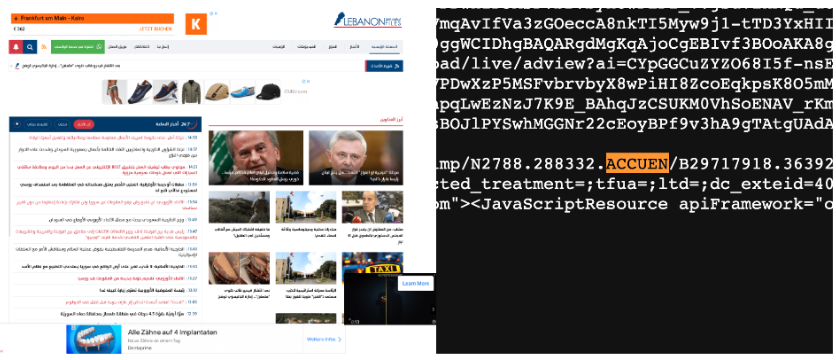
The list of media agencies and media buying companies whose Campaign Manager 360 impression pixels appeared in muted, out-stream, auto-playing TrueView skippable in-stream ads included:
Interpublic Group (Matterkind, Initiative)
Johnson & Johnson, Nike, Brembo, BMO bank, GoPro, Intuit
American Express (*though American Express is an IPG/Universal McCann client, this brand had a different, brand specific CM360 impression pixel)
Dentsu (Amnet)
General Motors, Sonos, Visit Scotland, Internorm International GmbH
Publicis (Audience on Demand, Precision)
Kitchen Aid, Emirates airlines, Maytag
Omnicom (Accuen)
Lotus Cars, Expo 2020 Dubai
WPP (Xaxis, Headlight, Essence)
Ford, Peloton, Sainsburys, Argos
Havas (Affiperf)
Bristol Myers Squibb, Goodyear Tire, O2
Jellyfish
Ugg
Brain Labs Digital
Financial Times (subscription campaign)
Horizon Media
Petco
Canvas Worldwide
Hyundai, Genesis
MiQ
Hollister
Surveyed marketers asserted that they consider mis-declared TrueView skippable in-stream inventory to be “ad fraud”
After identifying instances of TrueView skippable in-stream ad placements that did not appear to be consistent with Google’s public online documentation about the ad format, Adalytics surveyed several dozen marketers and digital advertising professionals to better understand their perspectives on TrueView skippable in-stream ads. The goal of this convenience sample survey was to assess whether marketers' expectations about TrueView skippable in-stream ads aligned with the observed placements of various ads in this study.
The survey was also prompted by a Linkedin comment from a Digital Marketing Director, who stated, “Nowadays, since buying 'YouTube' on DV360 also forces you to buy from their 'Video Partners' in the same line; I always wondered who/what those video partners were.
Unsurprisingly, the results look very underwhelming and self-serving for Google. I came to them to buy YouTube only; not a blend of YT + OLV sources I can get myself, from the same platform.”
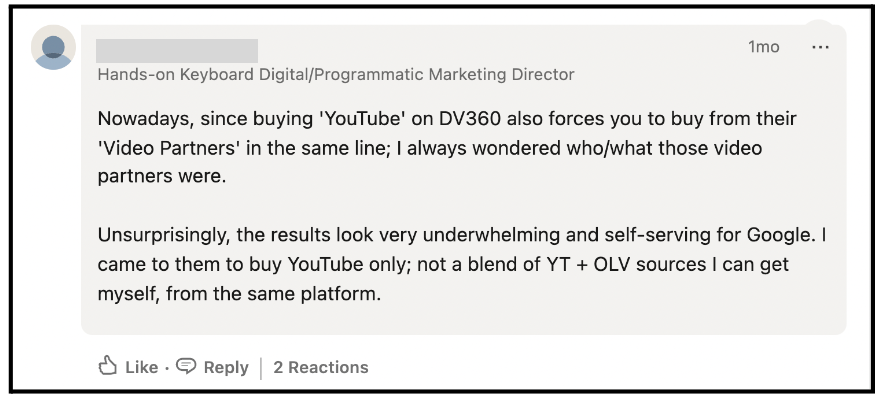
Screenshot of a Linkedin post comment from a Digital Marketing Director
Media buyers were shown ten examples of real TrueView skippable in-stream placements, and asked whether they would consider these to be valid TrueView placements.
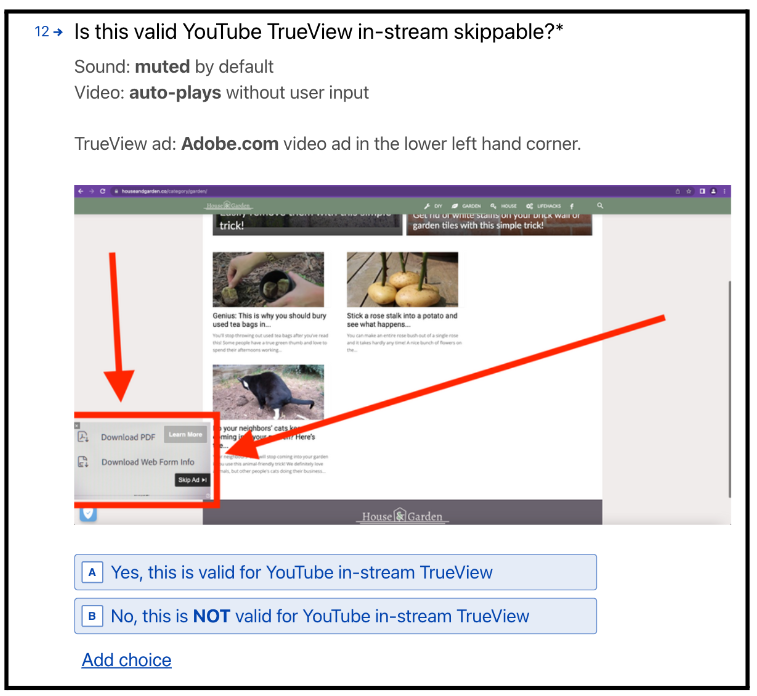
Example survey question posed to media buyers
For all ten examples shown, a large majority of media buyers responded that: “No, this is NOT valid for YouTube in-stream TrueView”.
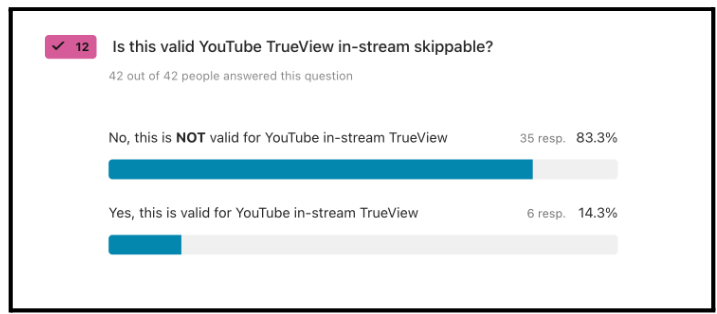
Example survey response
Furthermore, the media buyers were asked: “If you were sold "TrueView skippable in-stream" video ad inventory that actually ran on 3rd party websites as muted, auto-play, out-stream video, would you consider that to be "ad fraud" ?" 84% of surveyed media buyers responded “Yes” - suggesting that they would consider mis-declared TrueView skippable in-stream inventory to be “ad fraud”.
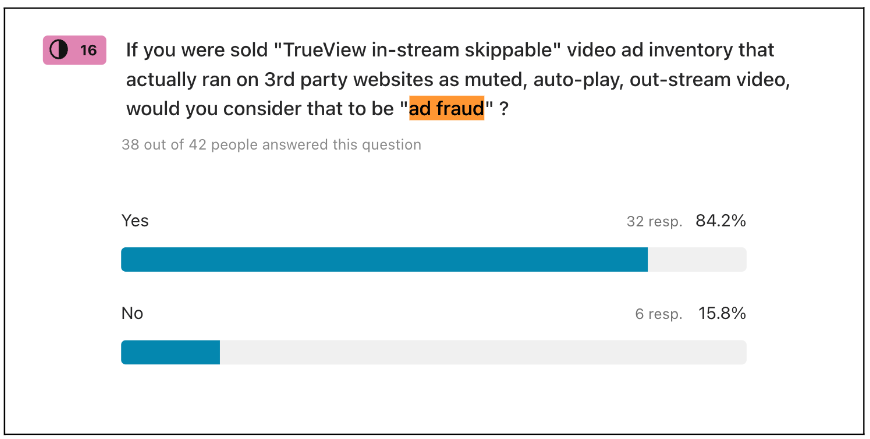
When asked to explain their reason in free form text responses, some of the media buyers responded:
“This is ad fraud because it is not playing in the way the product is described. It is not in stream - i.e. - it's not playing before/during/after content. Outstream, autoplay inventory would be worth much less than true instream video.”
“It doesn't match the description of what is being sold.”
“It is documented to be something other than what was received”
“outstream ads are different then youtube trueview ads. They appear in sidebar, corners, or within editorial content.”
“Per Google's definition it is required for TrueView Ads to be audible. If they are muted by default - this is a conflict of the understanding of how TrueView operates.”
“its outstream not instream as purchased”
“There is little chance the ad will actually have an opportunity to be effective”
“If its muted, its not true-view”
“The videos were clearly out-stream placements. They appear on sites with primarily written content (ie NOT video) and disconnected from the purpose of the websites.”
Furthermore, media buyers were asked:
“In your own words, how would you feel if Youtube was running large numbers of your ad campaign's YouTube TrueView in-stream video ads on: - 3rd party websites or apps, - with small, out-stream video players, - with sound off by default, - that were auto-playing with user involvement?”
The media buyers responded:
“I would demand a refund of all impression and third party costs associated with buying those ads. I would also demand that youtube/google block buying of these placements by default.”
“Cheated by Youtube. Not confident in future Youtube buys without plans to improve ad placements.”
“I would feel like I was ripped off.”
“I would feel like the inventory was unreliable, and not worth paying for.”
“Cheated out of my money.”
“would feel screwed”
“Fraud”
“That inventory ran in a way that was not in line with how it was purchased.”
“Pissed”
“Would feel like its not a transparent investment”
“Owed a massive credit”
“I would feel cheated. I would feel like i wasn't getting what i paid for”
“Betrayed and lied to”
Furthermore, a large majority of media buyers reported they would not buy TrueView skippable in-stream ads if they knew that a fair number of those video ads would serve in out-stream, muted, auto-play video players.
Conclusion
Caveats & limitations
Interpreting the results of this observational study requires nuance and caution.This study should not be construed as legal commentary or an opinion piece. This study does not allege that any entities knowingly or intentionally violated US Treasury sanctions or any other laws. This study did not make any extensive consultations with sanctions law or other legal experts. The study is meant to be viewed as a highly preliminary observational analysis of publicly available information and empirical data. This study cannot make any confident assessments on how much money, if any, was disbursed to sanctioned or sanctions-linked entities. It is possible that even though ads were displayed on various websites, none of those ads involved money being exchanged between different accounts. Furthermore, it is possible that certain entities received exceptions, waivers, or clarifications from the Department of the Treasury.
Secondly, the authors of this study take no position on whether any forms of “fraud” were committed or observed. Any mentions of “fraud” are the opinions of media buyers or external entities who were surveyed during the course of this study. Furthermore, in the situations where apparently (from this study’s results) non-conforming ads were displayed, it is unclear whether Google billed for these services, offered credits, or otherwise attempted to correct for the anomalies observed.
This study makes use of empirical data and open source datasets, but ultimately the methodology represents only a sample of the entire YouTube and Google Ads ecosystems. As such, any numbers cited in this report must be construed as estimates, and may not be representative of the broader ad ecosystem.
Furthermore, this study focused primarily on TrueView skippable in-stream video ad campaigns which had not been opt-ed out of serving ads on the Google Video Partner network. In some (but not all) types of TrueView skippable in-stream ad campaigns, it is possible for a media buyer to choose to opt-out of having their ads served on the Google Video Partner network. If such configurations were selected, it is likely that a media buyers’ exposure to invalid muted, out-stream video inventory would be zero percent.
Lastly, the study is highly predicated upon Google’s publicly stated policies, which may change over time or have multiple definitions.
Adalytics welcomes outreach from Google, YouTube, or any other entities that would like to help clarify or expand on observations or data from this study.
Discussion
This report analyzed data from participating advertisers and found that between 50-90% of advertisers’ TrueView skippable in-stream budgets were served on Google Video Partner sites and apps, rather than YouTube proper. The majority of those sites and apps did not appear to be consistent with Google’s published requirements for the TrueView skippable in-stream ad product. In some TrueView skippable in-stream campaigns, 42-75% of a brand’s TrueView ad budget is spent on invalid GVP sites and apps, where the ads serve in muted, out-stream or otherwise ineligible ad slots.
Throughout the course of this study, TrueView skippable in-stream ads for many entities were observed serving in muted, out-stream, auto-playing, and/or hidden video slots. These included political campaign ads for Senator Mike Lee, the sponsor of the America Act, ads for the Canadian New Democratic Party, ads for US federal government agencies such as Medicare, and ads for many Fortune 500 brands.
Many media buyers consider the placement of these ads to be inconsistent with the TrueView in-stream standard, and a subset of media buyers reportedly consider this phenomenon to be a form of “ad fraud”.
This report documented instances of TrueView ads serving on websites with tens of thousands of DMCA copyright violations, on websites discussing executions or children being murdered, on “made-for-advertising” sites, and on sites with no organic video media content. Furthermore, a significant amount of brands’ ad budget was delivered on gaming apps that appear to be intended for young children.
Google’s public online documentation states that “Google video partners are high-quality publisher websites and mobile apps where you can show your video ads to viewers beyond YouTube” and “Video partner publishers are carefully vetted and must meet Google's inventory quality standards” (emphasis added).
Based on the observations in this study, it is not clear how so many instances of copyright-infringing, made-for-advertising, or potentially US sanctions violating publishers were able to get past Googles’ careful vetting. If anyone at Google would like to further opine on Google’s inventory quality standards, please reach out.
Is “Google committed to complying with all applicable sanctions” ?
There have been at least four publicly documented instances where Google was observed serving ads, including those of Fortune 500 brands like Adidas, Citibank. and NBCUniversal, on websites or publisher environments that appeared to be under United States Treasury Office of Foreign Assets Control (OFAC) sanctions. In each case, a journalist notified Google of the alleged sanctions violations, and Google’s spokesperson typically responded verbatim: “Google is committed to complying with all applicable sanctions”.
In May 2021, Check My Ads Institute and Adweek found Google serving ads on OFAC sanctioned Russian intelligence disinformation outlets, including FSB-controlled sites SouthFront and NewsFront, that worked to “covertly influence” U.S. election processes and institutions.
an anonymous Google spokesperson responded: “Google complies with all applicable sanctions and trade compliance laws”, “If we find that an account violates these laws, we take appropriate action.”
In April 2022, Business Insider reported “Google's adtech served ads on sites explicitly named on the US Treasury's official sanctions list”. “Big companies such as Facebook, Citibank, and NBCUniversal may have unwittingly funded sanctioned businesses this way.”
an anonymous Google spokesperson responded: "Google is committed to complying with all applicable sanctions and trade compliance laws”, and "We've reviewed the sites in question and have taken appropriate enforcement action."
In July 2022, ProPublica reported that “Google Allowed a Sanctioned Russian Ad Company to Harvest User Data for Months”
Google spokesperson Michael Aciman responded: “Google is committed to complying with all applicable sanctions and trade compliance laws,” and “We’ve reviewed the entities in question and have taken appropriate enforcement action”
In October 2022, ProPublica reported that “Google continued to place ads on a publication in Bosnia and Herzegovina for months after the U.S. government officially imposed sanctions on the site. Google stopped doing business with the site, which the U.S. Treasury Department described it as the “personal media station” of a prominent Bosnian Serb separatist politician, only after being contacted by ProPublica.”
Google spokesperson Michael Aciman responded: “Google is committed to complying with all applicable sanctions.”
The fact that TrueView in-stream ads were delivered on delisted or side-loaded Android apps developed by entities based in Iran, suggests the possibility that Google’s ad business may have inadvertently sent money from Fortune 500 brands and US advertisers to entities under US Treasury sanctions.
Other media buyers reported in a Reddit thread titled “Refusal by Google to remove fraudulent Apps from Display targeting” that they tried to exclude the potentially US sanctioned apps from their advertising campaigns, but Google’s software tools rendered “an error message saying they could not be removed from the campaign.” After the media buyers raised the issue to Google’s support teams, the Google Support team “could not remove these links from our targeting.” The Google Support personnel “found that there is no issue at our end”.
If Google is indeed committed to “complying with all applicable sanctions”, why does Google’s software and support teams refuse to honor media buyer’s wishes, who wish to avoid purchasing potentially sanctioned and/or fraudulent ad inventory?
Furthermore, is allowing media buyers’ ads, including TrueView in-stream ads, to serve on potentially fraudulent, US Treasury sanctioned apps - consistent with Google’s Video Ad Safety Promise, MRC accreditation, or TAG certification? Is Google’s TrueView ad delivery consistent with its Media Rating Council (MRC) accreditation for brand safety?
YouTube received “content-level brand safety accreditation” from the Media Rating Council.
It is not clear whether serving TrueView ads on potentially sanctioned, side-loaded Iranian apps is consistent with YouTube’s MRC brand safety accreditation. It is not clear whether serving TrueView ads on Russian state sponsored propaganda sites or gaming apps meant for young children is consistent with YouTube’s MRC brand safety accreditation.
Furthermore, it’s not clear the degree to which the MRC audited YouTube’s brand safety mechanisms for ads served on Google Video Partner sites (GVP), where up to 90% of a brand’s TrueView ad budget may deliver against. The only mention of YouTube brand safety, MRC accreditation, and the Google Video Partner network can be found in a May 2022 Adweek article.
Is TrueView ad delivery consistent with Google’s TAG Brand Safety and Certified Against Fraud seal?
Google received TAG’s Certified Against Fraud seal and Brand Safety Certification, which requires that any participating company acting as a seller or intermediary must:
disclose “staff and/or tools/technology used to review or flag content disclosing from media properties associated with piracy.”
“A participating company acting as a direct buyer, intermediary, vendor or seller should employ a TAG-recognised content taxonomy for harmful content” and “Digital advertisements may not be displayed in association with any content categories” such as “Online Piracy”, “Sensitive Social Issues”, “Death Injury or Military Conflict”.
“must employ pirate mobile app filtering for all advertising displayed in a mobile app environment.”
This study observed instances of YouTube TrueView in-stream ads being served on sites with tens or hundreds of thousands of DMCA copyright violations, sites discussing executions and childrens’ murders, and on potentially sanctioned foreign mobile apps which use “reverse engineering” to extract content from Instagram.
Given these observations, it is unclear whether Google’s serving of YouTube TrueView in-stream ads is consistent with its TAG Certified Against Fraud seal and TAG Brand Safety Certification. Are the YouTube Measurement Program (YTMP) vendors providing true verification and measurement for TrueView ad buys?
As mentioned before, YouTube does not allow independent 3rd party measurement vendor pixels to be served on its ads. Some sources speculate that the vendors that are part of the YouTube Measurement Program (YTMP) only receive aggregated reporting data about YouTube ad placements from YouTube itself, via server to server data delivery (the “YouTube data feed”). If these vendors are getting data from YouTube’s servers, rather than by independently measuring placements on phones, computers, and TVs, it is unclear the degree to which YTMP can independently check YouTube’s’ ad delivery.
Careful review of the marketing copy of several of the YTMP’s websites reveals only mentions of the word “channels”. There are no references to the Google Video Partner network, “apps”, or “websites” in the YTMP’s content. This begs the question - are the YTMP’s receiving any data on the 50-90% of advertisers’ TrueView budget that is serving against the GVP sites and apps? In 2020, the Wall Street Journal (WSJ) reported that “Google wants to substantially limit the information a key auditor of YouTube can share about the risks of advertising on the video service”. WSJ wrote that an auditor “is refusing to sign a contract that would prevent it from reporting to clients when ads have run in videos with sensitive subject matter, including hate speech, adult content, children's content, profanity, violence and illegal substances, according to an email the firm sent over the weekend to ad agencies.” One senior media agency executive - when shown an advanced copy of this research report - stated:
“It shows that industry certified verification like the MRC and TAG has no credibility. 3rd Party Verification vendors are either incompetent or intentionally fraudulent and worse seem complicit with Google in a deliberate scheme to exploit advertisers and the industry via a deceptive “verified partner” program.”
Should the Google Video Partner network be opt-in rather than opt-out for TrueView in-stream ad buys?
As discussed earlier, for certain types of TrueView campaigns, it is not possible for TrueView skippable in-stream media buyers to elect to opt-out of placing ads on the Google Video Partner (GVP) network. Furthermore, for virtually all skippable in-stream campaigns, the GVP network is automatically opted-in; media buyers must opt-out (if they are even given that option).
Given the concerns about potential US Treasury sanctions violations, copyright infringing publishers, muted out-stream video players, made for advertising sites, and significant numbers of foreign gaming apps for children, it is understandable why media buyers may be reluctant to purchase ads from the Google Video Partner network when their objective is to exclusively place ads on YouTube.
For certain brands who have high requirements for brand safety and compliance with US sanctions laws or childrens’ privacy laws, being forced to buy ads on the Google Video Partner network while executing a TrueView or skippable in-stream buy may preclude them from advertising on YouTube completely.
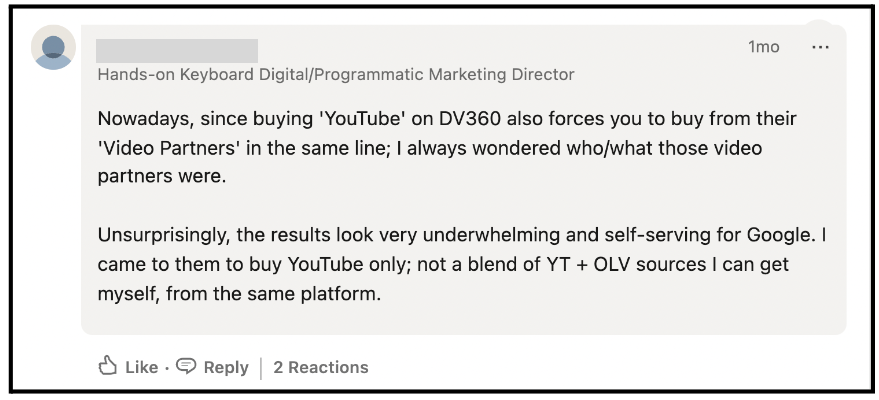
Did Google transact large amounts of “invalid traffic”? According to Google’s documentation on the “Definition of invalid traffic”, “Invalid traffic includes any clicks or impressions that may artificially inflate an advertiser's costs or a publisher's earnings. Invalid traffic covers intentionally fraudulent traffic”.
Google’s online documentation states that mis-declaring out-stream video ad slots as in-stream is a form of “invalid traffic.” However, this study noted many instances where TrueView skippable in-stream video ads appear to have been rendered on out-stream video ad slots.
Thus, these observations and Google’s written attestations beg the question - did Google itself enable large amounts of “invalid traffic”, thus artificially inflating advertisers’ costs?
As mentioned in the previous Results section of this report, one surveyed media buyer expressed his concerns about TrueView skippable in-stream inventory thusly:
“I would demand a refund of all impression [sic] and third party costs associated with buying those ads. I would also demand that youtube/google block buying of these placements by default.”
Adalytics shared an advanced copy of this report with Ebiquity, a major marketing and media consultancy which helps brands audit their ad buys. Ruben Schreurs, the Chief Product Office of Ebiquity noted:
"The research report by Adalytics is highly incriminating. Based on the findings and allegations represented within, I see this as a structural misrepresentation of advertising products at best, and downright fraudulent misleading practices at worst. If true, this will have major repercussions in the industry and lead to a significant negative impact on Google's perceived quality and reliability. Ebiquity works for over 75 of the top 100 brands, nearly all listed in this report as possibly being exposed, and we will initiate a large-scale review of this immediately. We thank Adalytics for their hard work in this and previous cases, and look forward to a detailed reply from Google."
⚠️ Note: A PDF copy of this report can be downloaded from this URL link. ⚠️

